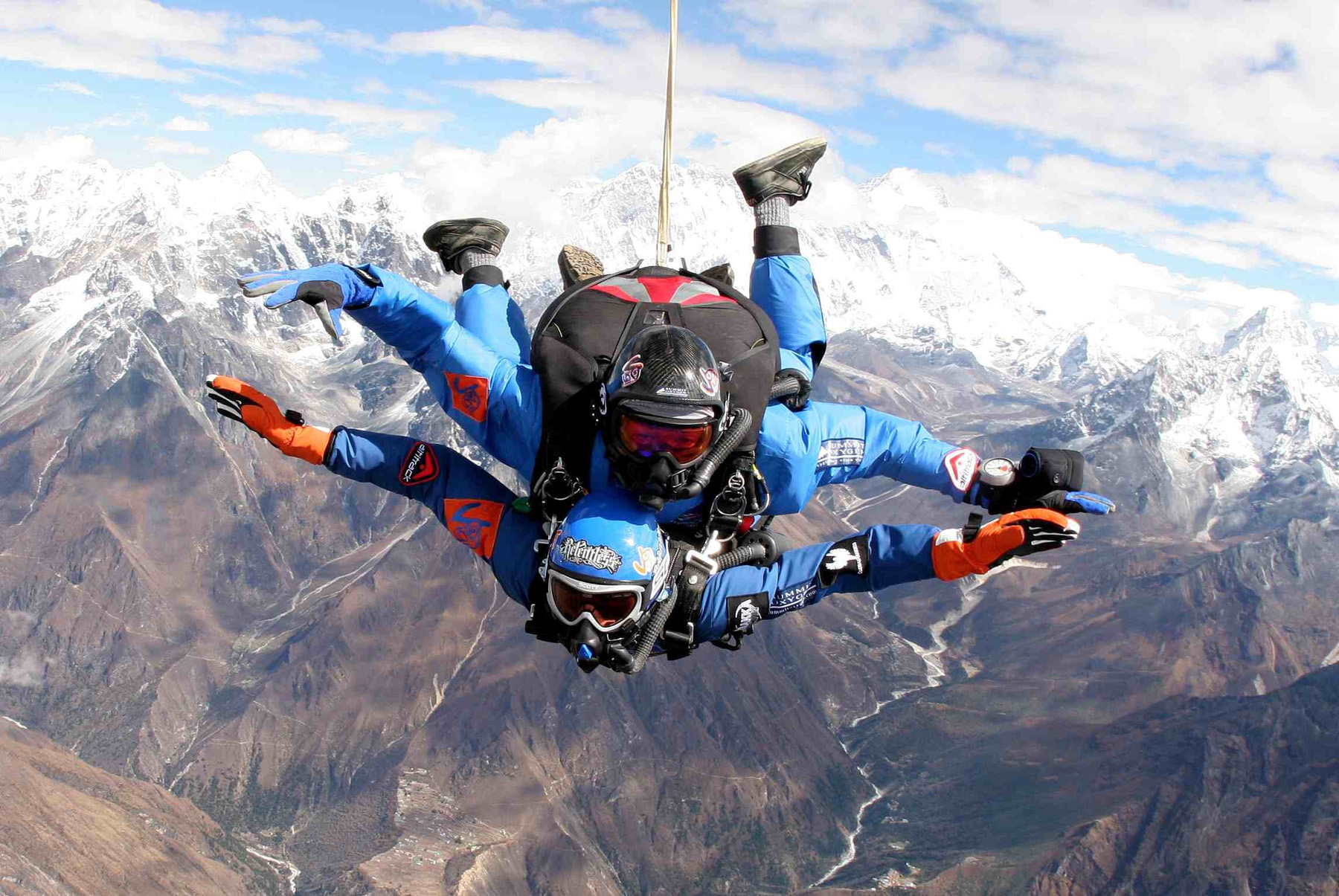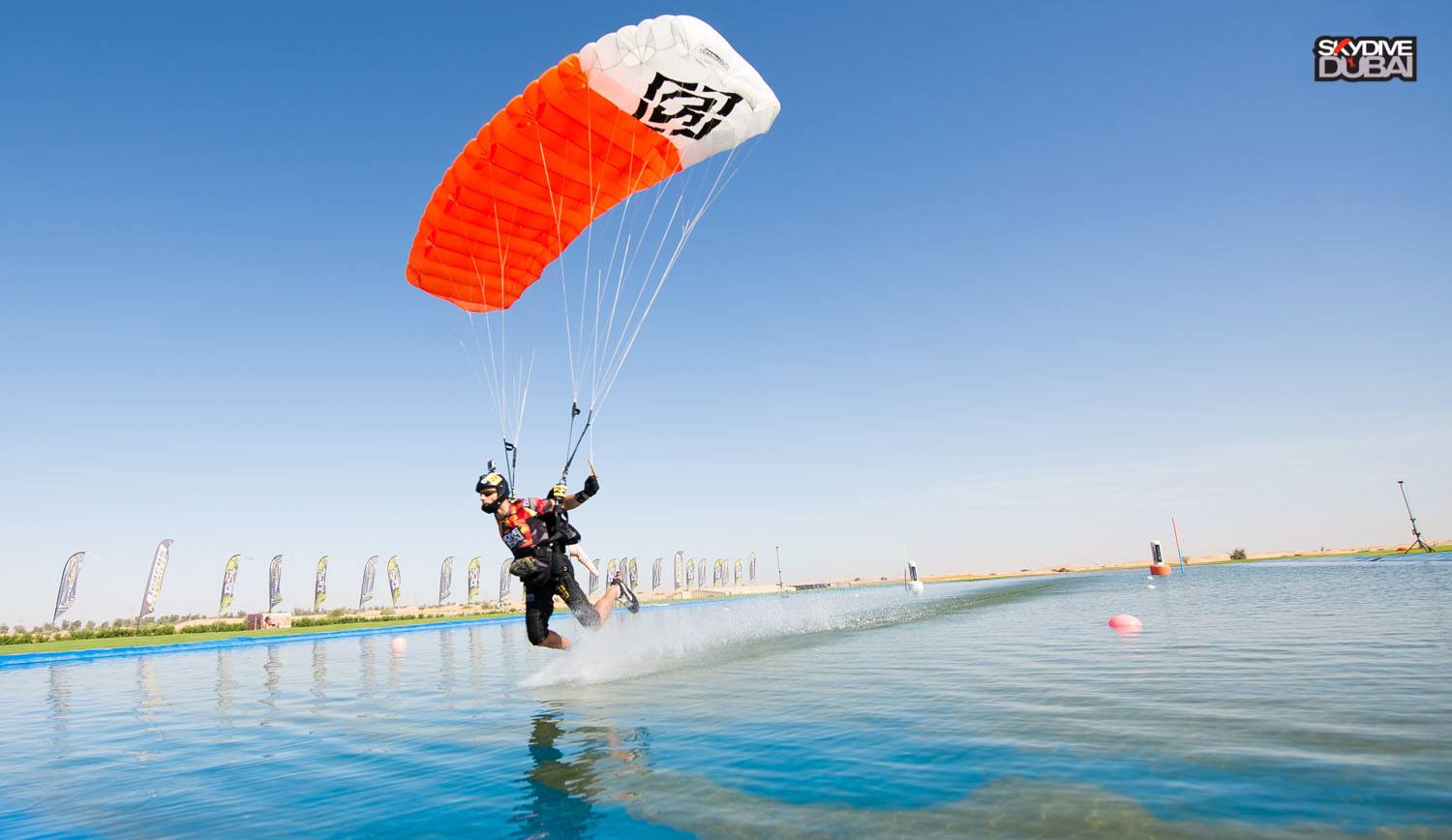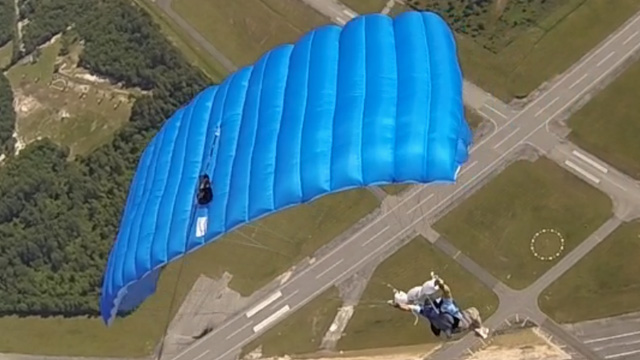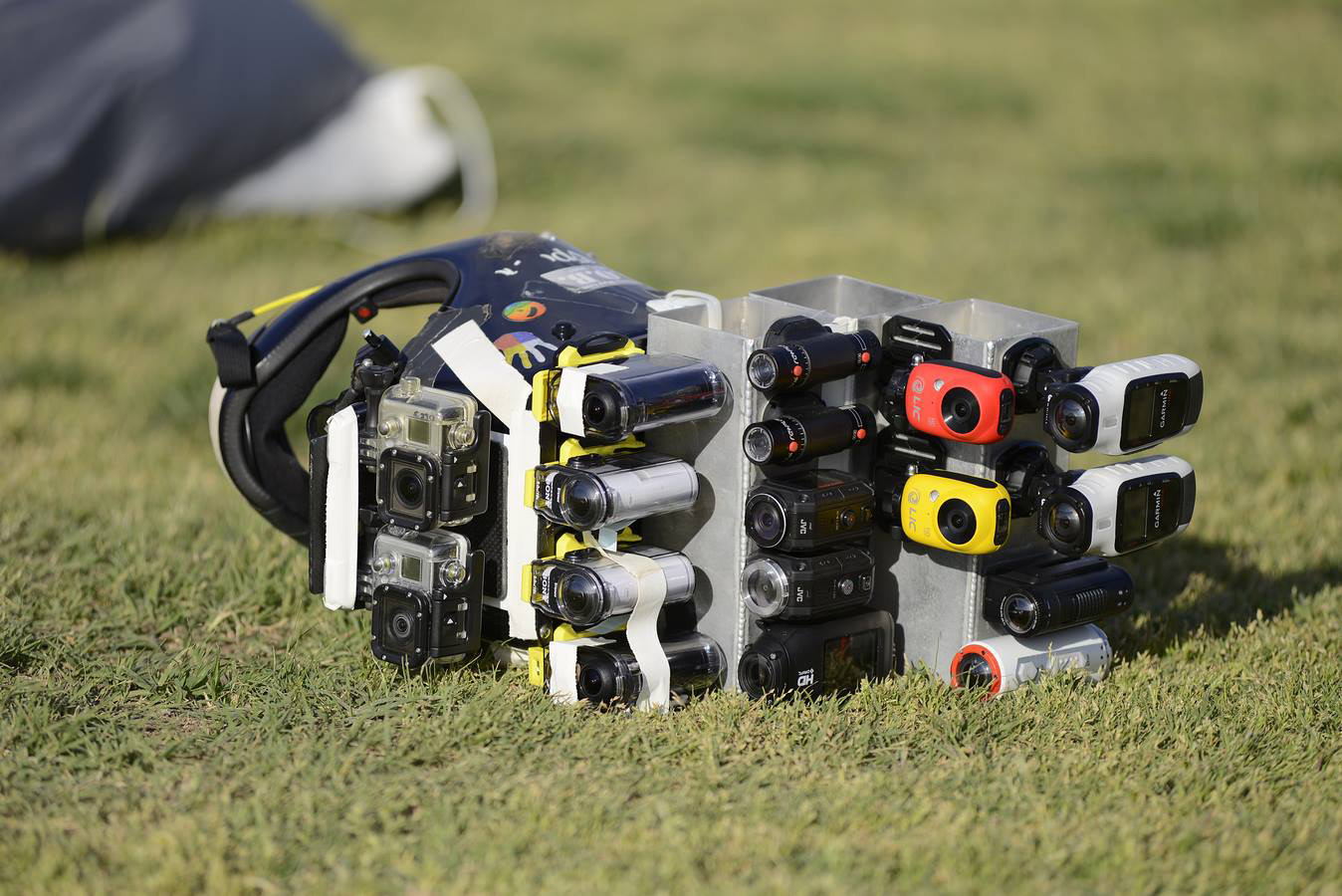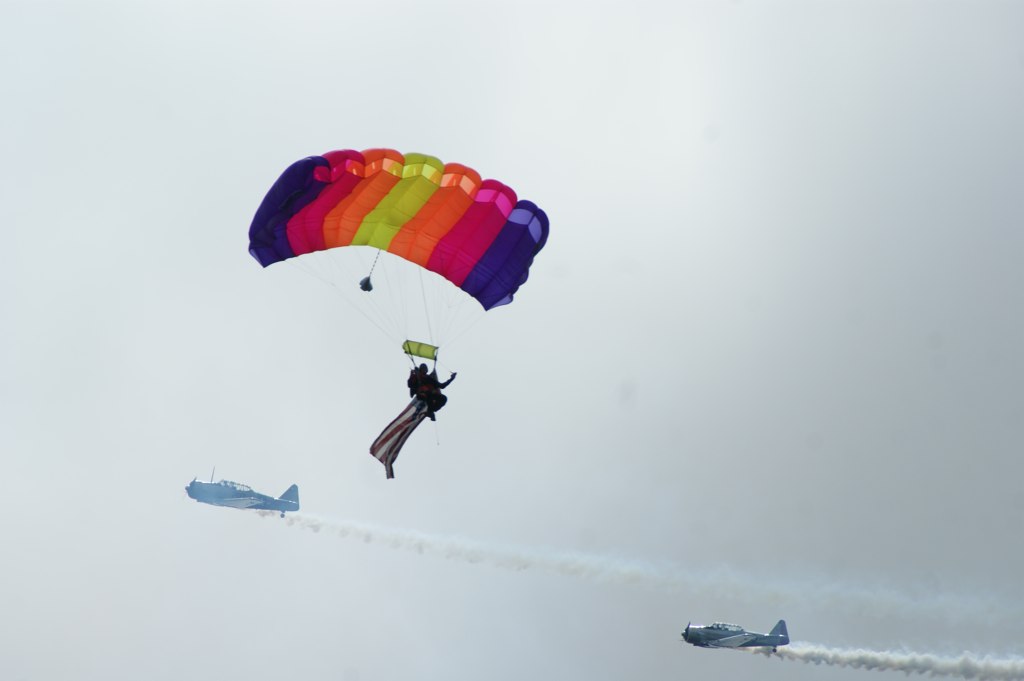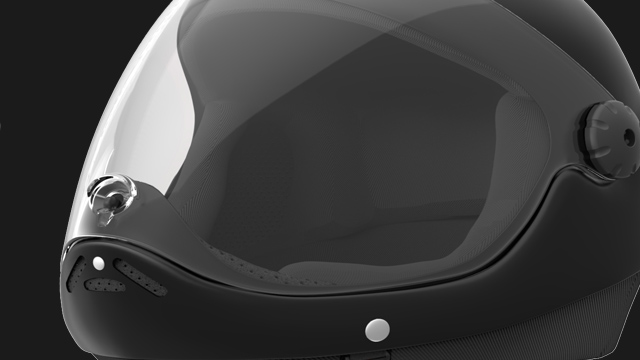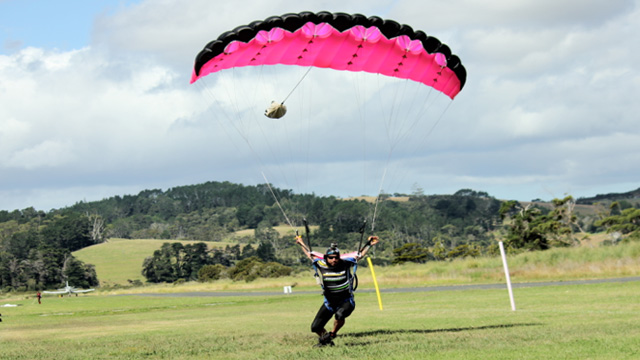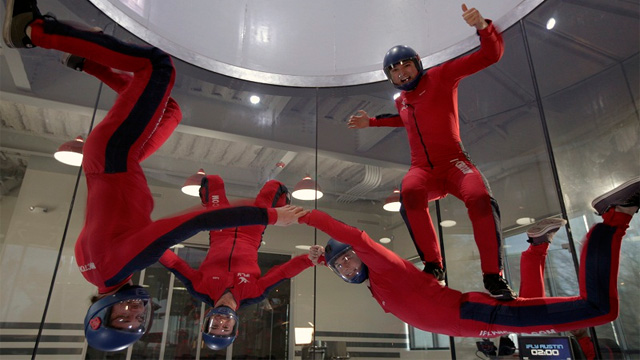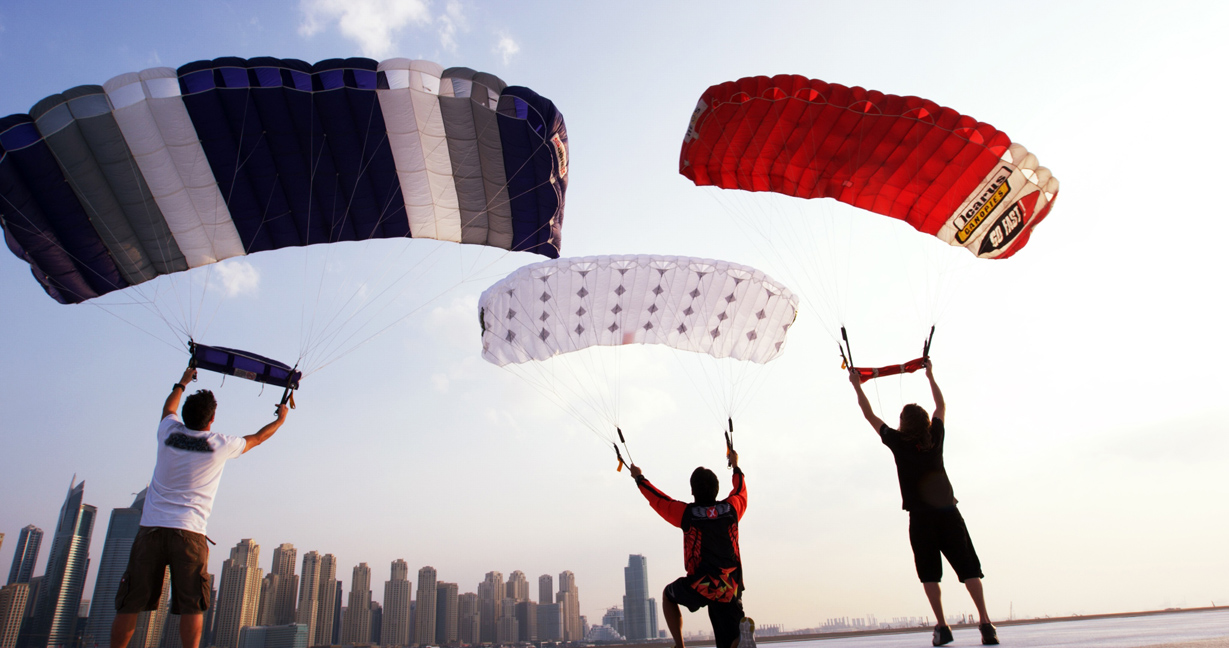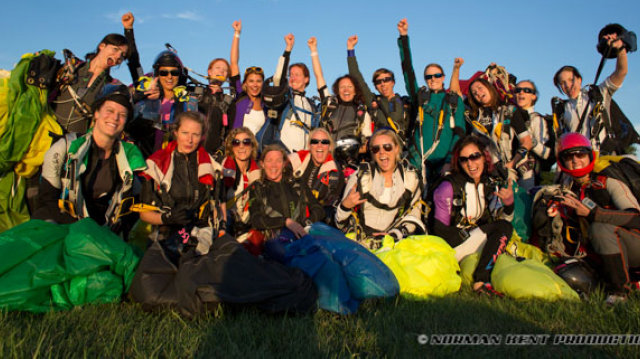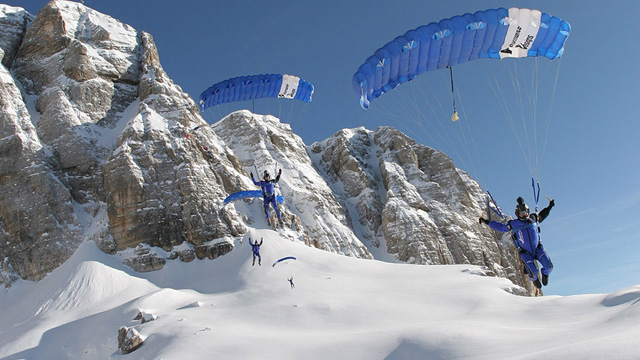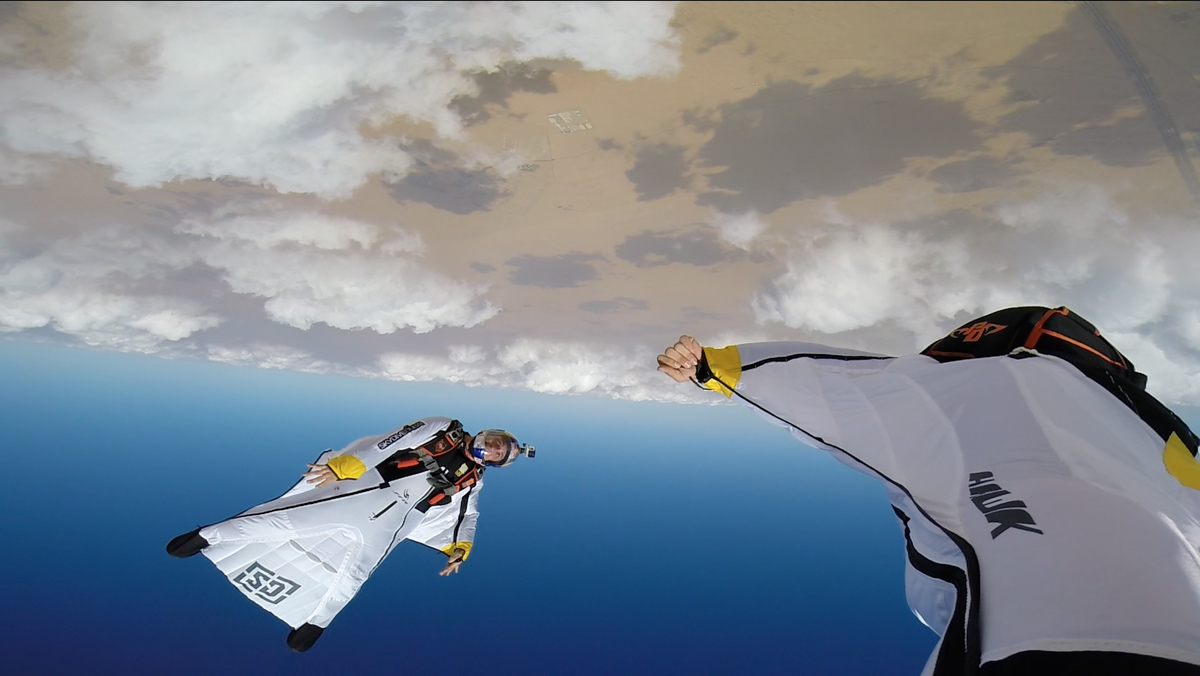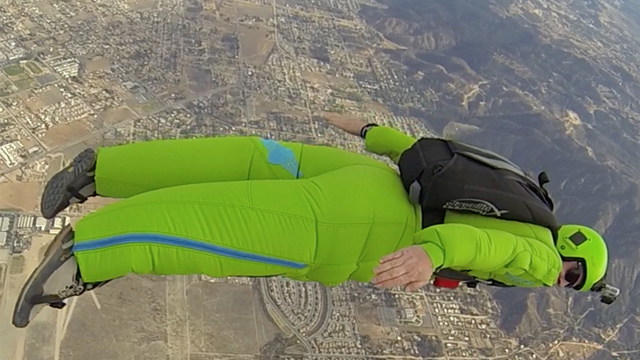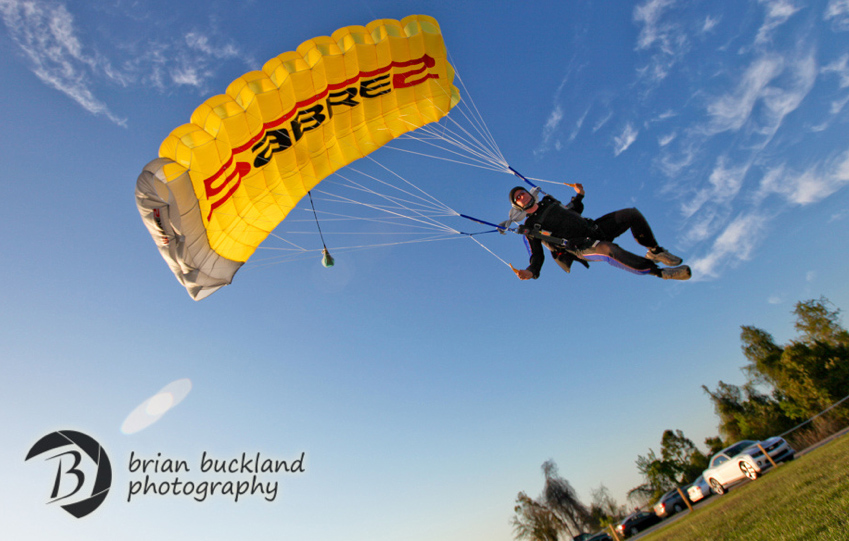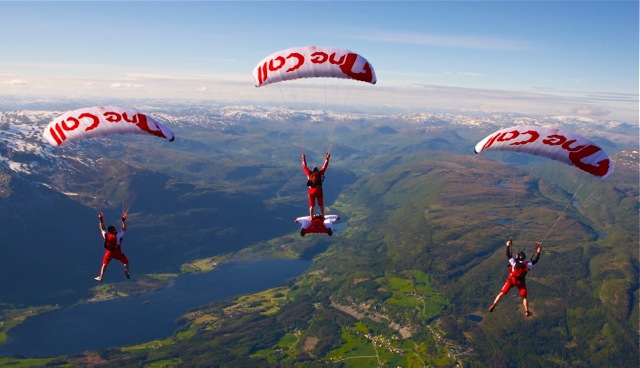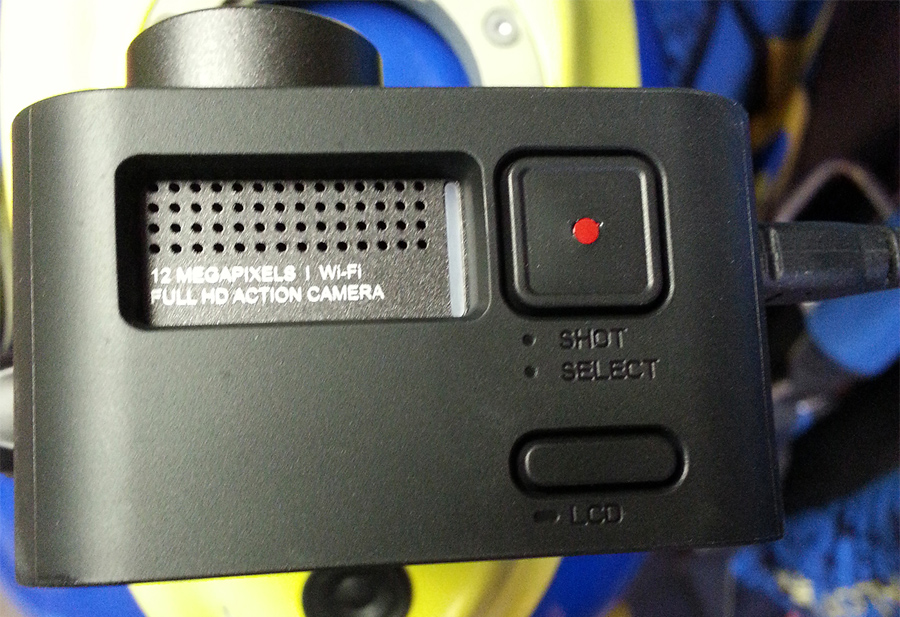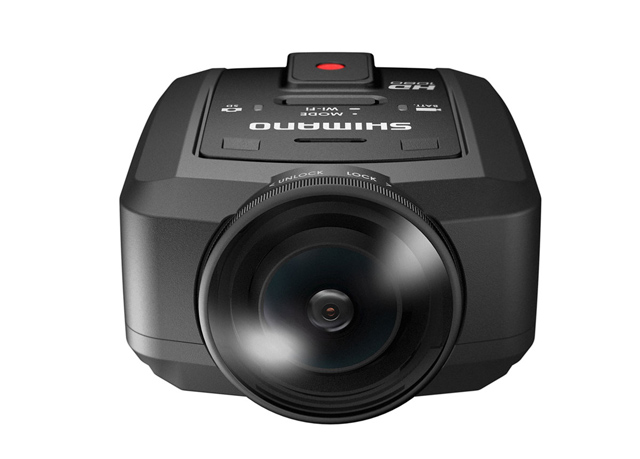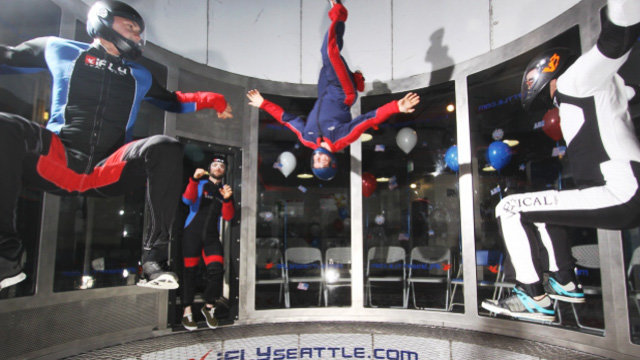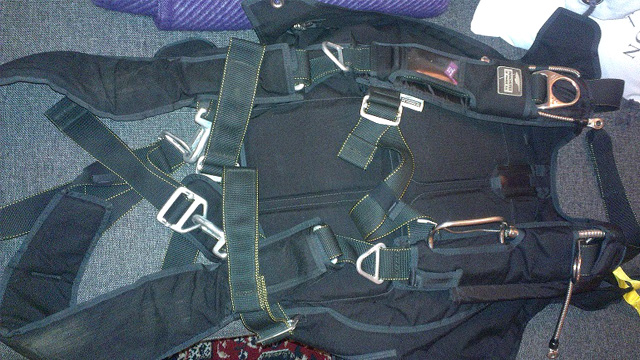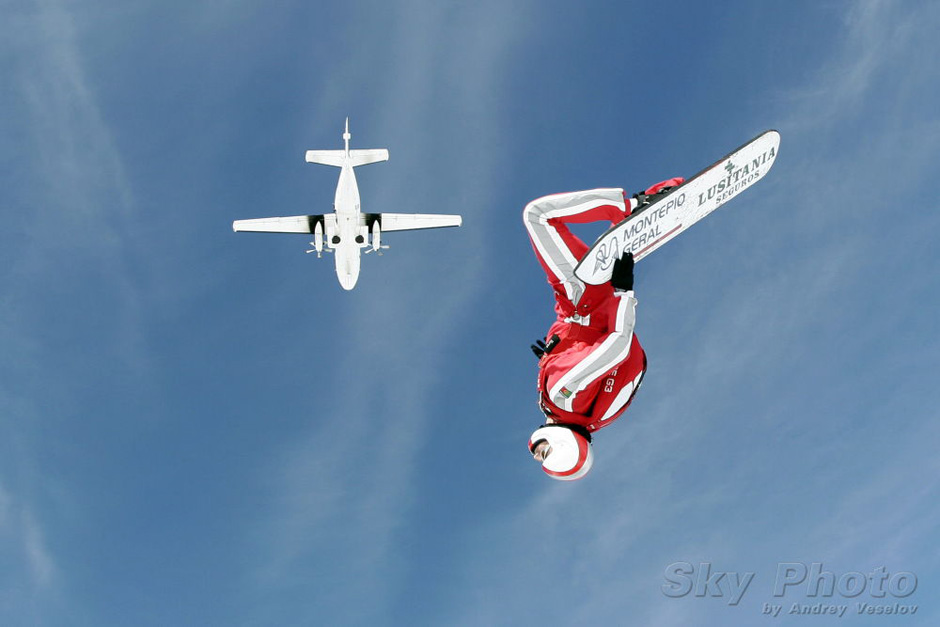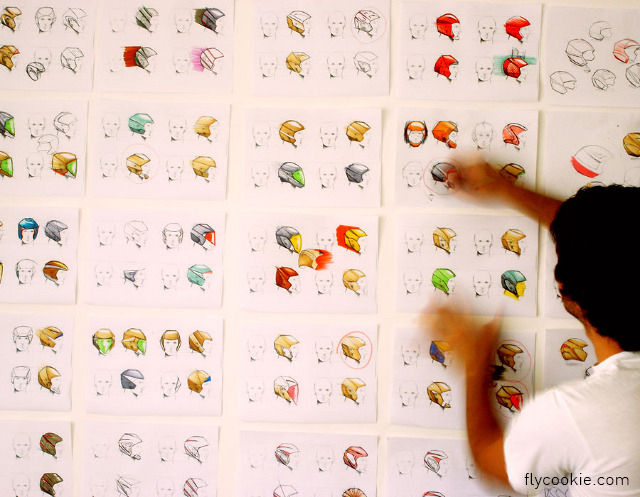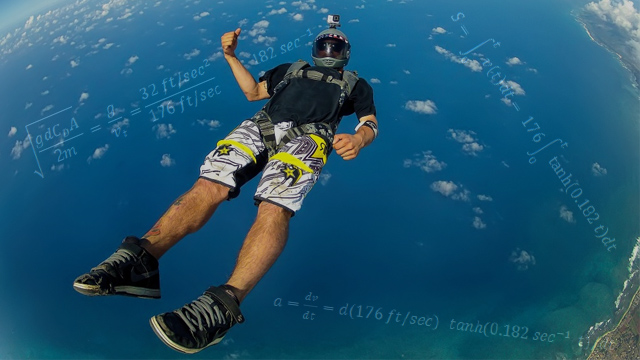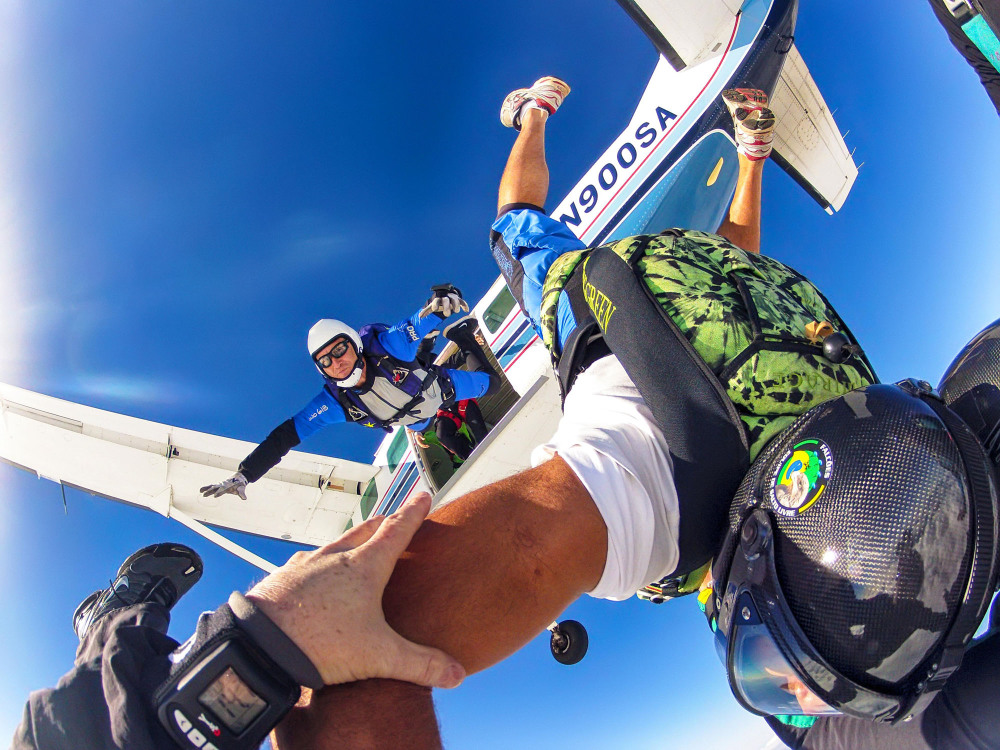Search the Community
Showing results for tags 'news'.
Found 523 results
-
A Himalayan Adventure That Continues To Reinvent Itself In late October 2014, Everest Skydive is set to enter into it’s seventh year of operation and make it’s eight expedition into the Nepali Himalaya bringing skydiving back to one of the earth’s most remote locations. In between the traditional scenery of climbers, trekkers, sherpas and porters, skydivers and their parachutes will once again be seen flying through the skies of the Khumbu region and Sagarmatha National Park. Arriving at this point, entering a seventh year after the first skydives were made in 2008, has been a path as challenging as any of the paths that lead to Everest Base Camp. Each year, as logistical challenges emerge and operational needs change, the expedition faces a year long challenge to bring skydiving back to Nepal. “Eleven months of hard work for one month in the Himalaya working even harder” has been the mantra of the team and expedition, composed of an international mix of skydivers and mountaineers. Over the years Everest Skydive has seen many changes. Whether it was aircraft support shifting from the Pilatus PC-6 to the AStar B3, or helping promote charities like Global Angels, to opening up new remote dropzones, the Everest Skydive expedition has constantly evolved to meet the needs of the local Nepali tourism industry and to bring high altitude skydiving and canopy flight to higher and higher dropzones. Seven years ago, the idea of safely landing sport and tandem parachutes at 12,350ft MSL was considered by many to be an impossible task. Yet, as each expedition successfully ventured further and further into the Himalaya, landing parachutes closer and closer to Everest Base Camp, this team of international skydivers proved beyond a shadow of a doubt that with today’s modern parachute designs providing cutting edge technology and performance envelopes, that high altitude parachute landings were not just the realm of stuntmen and world record seekers. As each year came and went, stand up landings at dropzones at 15,000ft MSL in Ama Dablam Base Camp, or 16,900ft MSL into the Gorak Shep lake bed, or even 17,192ft MSL onto the Kala Pattar Plateau proved that modern canopy flight and landing was sustainable at these altitudes. As each expedition would come to a close however, the team would search the Nepali landscape for new and exotic locations to bring skydiving into. After establishing those four dropzones in the Eastern Himalaya, the team’s founder Suman Pandey suggested the team head west to Pokhara, a lakeside Nepali tourist location beneath the Anna Purna Range of the western Himalaya. With a DZ elevation of 3,300ft MSL, Pokhara Skydive allowed for the Everest Skydive Himalaya experience without the added cost and complexity of the bail out oxygen systems that the higher eastern Nepali Himalaya region required. Pokhara Skydive then evolved into Everest Skydive’s first “consumer friendly” (not incredibly expensive) skydiving expedition for local tourism based sport and tandem skydiving. Not to be content with just bringing skydiving to the western Himalaya however, the team “borrowed” an AStar in 2013 and went scouting for another remote high altitude location. They found it in a village called Manang, located in a valley with an elevation of 11,500ft MSL, and with the help of the local government, were able to create a sustainable high altitude dropzone in Manang, Nepal as well. With all the exhausting effort put into creating successful skydiving expeditions into the Himalaya each year, the staff was known to periodically take a week off together after Everest Skydive and trek on foot up to Everest Base Camp to connect with the local friends and families that they had become a part of over the years. This expedition to Everest Base Camp received so many questions from friends and family back home over the years however, that the team began to open up the trek and invite others to join in on this life changing experience of making it all the way up to Everest Base Camp. What started out as a handful of friends, turned into a group of twenty people hitting the trails in two stages in 2013 and the 2014 expedition looks to bring between 20 and 30 skydivers and friends of skydivers on a trek to Everest Base Camp with skydiving in the western (and way more affordable) Himalaya region of Pokhara after the trip to Everest Base Camp. One of the strengths of the Everest Skydive expedition and it’s Everest Base Camp and Pokhara Skydive evolution is in the company that the team works with. Fishtail Helicopters has been providing Everest Skydive and their guests with the world’s most reliable high altitude helicopter support. And in a region like the Himalaya, the word “reliable” can be the difference between skydiving all day in a remote location or sitting on a hillside wrestling a parachute container away from a local yak…….Helicopter support for jump operations, helicopter support for medical evacs if needed and most appreciated it would seem……helicopter support to depart the Himalaya after reaching Everest Base Camp. Most everyone that reaches Everest Base Camp feels a little tinge of anxiety as they start to head back down the mountain, as they suddenly realize, with their goal behind them, that they still have a 3 day walk back out of the park to catch a Twin Otter back to Kathmandu. Not Everest Skydive and it’s group however……since the team works directly with the AStar owners, they coordinate flights out from the Himalaya the day after reaching Everest Base Camp. Facing a 3 day walk, instead the team flies out on an 8 minute terrain flying AStar flight back to Lukla Airfield, back to the world. The word “epic” can be a cliché at times, not here though, not on this flight. It has to be experienced to understand it, but for those that already have, they know. That’s the story more or less, seven years of hard work by a small group of highly motivated international teammates that continue to bring the “top of the world” within reach of the skydiving universe. It’s an expedition that continues to grow and evolve like the remote ecosystem around it. And at the end of the day, whether it’s skydiving beside Mount Everest or sharing a lemon tea with a sherpa family and friends, the Everets Skydive expedition continues to make the world a little smaller by bringing people together from different cultures and countries and giving them all the same thing to believe in, that people are capable of accomplishing anything as a team. For more information on Everest Skydive, you can contact Tom Noonan via e-mail.
-
The Dubai International Swoop League (DISL) organised by Skydive Dubai and The Emirates Aerosports Federation (EAF), ended with a bang in April 2014. DISL is a platform that provides skydivers with a controlled and safe learning environment to better understand how to handle parachutes. In skydiving the most dangerous part of the sport is learning how to pilot and land parachutes safely, with the advancements in technology skydivers need to ensure they stay abreast of all the new criteria. The 5th and final meet of the year brought together a total of 38 participants from UAE, USA, UK, Qatar, New Zealand, Ireland, Australia, Russia, Yemen, Romania and South America, all competing for the top spot. DISL consists of three categories that skydivers can compete in; PRO, Intermediate and Beginner. Skydive Dubai gave away $2500 for first place, $2000 for second place, and $1500 for third place in each category, the highest cash prizes available for this type of competition around the world. “Skydive Dubai has the best training facilities in the world for all disciplines in skydiving. We want to create fun learning experiences for anyone living or traveling to Dubai for skydiving.” Said Patrick Kaye, Athlete and Canopy Piloting Team Leader, Skydive Dubai. With the ongoing support of Sheikh Hamdan Bin Mohammed Bin Rashid Al Maktoum, His Excellency Nasser Al Nayadi and Raul Bocanegra, DZM of the Desert Campus, DISL continues to be an expanding stage of knowledge and skill. This year’s meets were judged by the FAI Emirates Aero sports federation. Results: PRO: 1st Place: Pablo Hernandez 2nd Place: Billy Sharman 3rd Place: Patrick Kaye INTERMEDIATE: 1st Place: Darius Turcinskas 2nd Place: Laszlo Csizmadia 3rd Place: Ashton Wood BEGINNER: 1st Place: Jarret Martin 2nd Place: Oliver Noel 3rd Place: Henrik Koskela Billy Sharman, second place winning in the pro category stated, “The DISL is a superb competition, the entire Skydive Dubai family should be very proud to have such a fun and very well organized event as part of their event schedule.” Skydive Dubai Desert Campus cordially invites all Skydivers from around the world to participate in the 2015 season which will begin in December 2014. Once again, 5 competitions will run throughout the season, one per month, until April 2015. Anyone with a B license can participate and each competition will have 3 levels of experience in order to cater to all levels of canopy piloting. For more information, please follow the Skydive Dubai Desert Campus Facebook page or contact any member of the Skydive Dubai Swoop Team or staff member at the Skydive Dubai Desert Campus.
-
Fluid Wings is a new and innovative company based in DeLand, Florida - which is aiming to close the gap between the parachuting, speed flying and paragliding. The company was born through a love of human flight, and focus on an engineering-based approach. Fluid Wings draws from the expertise of Scott Roberts, a skydiver with over 15 years experience, who has been competing for more than a decade; Kevin Hintze, an active pilot, paraglider, speedflying instructor and test pilot; as well as Shane Shaffer, chief test pilot and production lead. From the first of June this year, Fluid Wings will begin production on their newest main - The Prime. The Prime will be a 9-cell hybrid main, available initially in sizes from 150-190 square foot in a combination of ZP and low porosity nylon. The canopy is aiming to provide pilots with a fun and predictable flight, with focus also being placed on how easy it is to pack. The Prime will look to cater to jumpers of all experience, being easy enough to handle for newer jumpers, while still being responsive enough to be fun for the more advanced skydivers. Stock colors are Royal Blue top skin and stabilizers, with a white bottom skin and ribs. Please note that bottom and rib colors are limited to white due to color section of low bulk fabric. The canopy ships with Vectran lines and soft-link connectors, with a low-bulk option packing up to a size smaller is also available. “The Prime is responsive and playful, while still easy to manage. It has a good glide for those long spots, with a nice strong flare for tip-toe landings,” said Scott Roberts of Fluid Wings. “We like her a lot and think jumpers will too!” The Prime will retail for $2090 with all options. You can contact Fluid Wings at [email protected] for more information, purchases or demo requests.
-
Action cameras aren’t merely changing the production world, they have become a staple of the production world. Getting the inside shot is simple with POV cameras and the number of choices in this niche world is broad and perhaps daunting. Action cameras are inexpensive and provide a simple means of additional camera angles to any production. In this review, I’m going to tackle all of the “name-brand” cameras available out there. This article will not provide the answer to “which camera should I buy?” The range of criteria is so broad that the question is beyond the scope of a single review. This review will provide information about which action-camera is best suited for specific criteria and provide information that may help you make informed purchasing decisions. I’ve gathered what I believe to be the most viable options for most “extreme” sport enthusiasts for shooting broadcast-quality video. During this review, each camera is set to 1920x1080, 30fps (except where otherwise noted). The criteria for inclusion: Price point (150.00-400.00 USD) Bit-rate (16Mbps or higher) Codec (must be non-proprietary) The selectees: GoPro 3+ ($399.00) GoPro 3 Black ($349.00) Sony AS100 ($299.00) Sony AS30 ($299.00) JVC Adixxion ($299.00) Midland XTC400 ($249.00) Polaroid XS100 ($169.00) ReplayXD Mini ($199.00) Liquid Ego ($179.00) Drift Ghost S ($399.00) Scoring Procedure With the criteria determined, particpants selected, I created a scoring sheet that could be used as a reference throughout the process. The goal is to be as objective as possible in a subjective conversation. A panel was selected, four people who would review images from the cameras and choose the best image when image quality was relevant. Other factors such as battery life, wireless functionality/reliability, audio features/quality are objective. Scores are based on how these functions are implemented and may be relied upon. For this shootout I mounted 17 action cameras on a single helmet, then took it skydiving, snorkeling, zip-lining, bob-sleighing and motorcycling to enable accurate side-by-side comparisons of each camera. For example in the battery life test, the Liquid Ego went for nearly 5 hours of record time, blowing through a few cards, while the Garmin VIRB and GoPro 3 Black barely reached 50 minutes of record time. The Liquid Ego nets a score of “5” while the Garmin VIRB and GoPro 3+Black earn a score of 2. The Sony AS series weighed in at just over 2.75 hours earning a score of “4”. Had it not been for the curve-altering record times of the Liquid Ego, the Midland and Polaroid cameras, Sony’s AS100 would have won this category. Regardless, with a linear scoring value of 0-5, the weighting may seem unbalanced from time to time. Please note that the score card contains two scores; one based exclusively on image quality, and the other score relevant to the overall product experience. Most of the cameras have tweaks and settings that allow them to be the best they can for specific situations. Rather than setting each camera to its best settings, all cameras were used exactly as they come out of the box. In other words, once the box was opened the battery was charged, a card inserted into the camera and formatted, it was put to the test. Sony, GoPro, and ReplayXD all have internal tweaks accessible via either proprietary software or .txt files. Each allow for an optimized image even though I’ve avoided using any of these optimizations. After all the results were in and the panel gave their feedback, here's what the final result looked like. I sorted the score sheet below by total score but you can click on any header to sort the table by that column and see how the different cameras compared in any specific test. I discuss each test area in detail below. Score Sheet Image Quality Winner in Image Quality - Sony AS100V The subject of image quality is subjective. The four panelists had to choose from a variety of videos (a few of which are linked in this article). Factors involved in the comparison are dynamic range (darkest to the brightest representation of image content), saturation, color accuracy, codec compression/banding/pixelation, motion management, and frame to frame blurring. Watch the Wingsuit Exit Video For example, in the image above, the center top allows for the lake in the background to be seen, while also allowing for the darker interior and tires of the aircraft to hold details. There are no blowouts of the highlights, and the reds, greys, whites, and orange colors are all accurate to original. Watch the YouTube-linked video at the 4K resolution on YouTube for the best experience and ability to determine which image you find best. Each camera is displayed at approximately 720p. You’ll likely want to turn off your audio as there is no usable audio content. Watch the Zipline Video Watch the Bobsled Video In the above test, one of the cameras failed due to (I believe) card error. The high motion, high contrast, light and dark areas for exposure testing provides for a terrific challenge. Even in the still framegrabs, the torture is evident in blur, color, and compression artifacting. Watch Wingsuit Overhead Video The complexity of the ground coupled with the high motion makes for a good test of contrasts and detail management in moving platforms. Note that the majority of the cameas are set to an FOV of 120 degrees, as that’s how they come out of the box. A couple cameras are 170 degrees. All panelists unanimously chose this action camera over all others in all resolutions and framerates. The GoPro 3+ came in second. The Sony AS30 takes third prize, and an honorable mention goes to the Drift Ghost S. In well-lit situations, the Midland and Garmin VIRB cameras really surprised me too, but at 35Mbps (this camera also does 50Mbps in XAVC-S mode, not used in this shootout), the Sony AS100 sweeps the image quality score. Battery Life Winner in Battery Life - Liquid Ego This was a stunner. I left all the cameras running/recording and went to dinner. Battery life would be lessened by movement, but the bigger point was how long the cameras could record. In most cases, the camera battery died prior to the card being filled (I used 16 GB cards for this test). The Liquid Ego kept running and running, filling a 16 and then 8 GB card before finally dying at just under 5 hours in 1080 mode. Wifi was disabled (all wifi was disabled for most tests). This is one of the least expensive cameras in the shootout; it has some shortcomings, yet one major bonus is that this camera, removed from its own mounting clip, can be fitted to GoPro mounting systems. Brilliant move on the part of Liquid! What I didn’t like about this camera are the number of button presses to record in 720-30p or 60p without wireless enabled. However, shooting in 1080 mode is as simple as turning it on and hitting record. When in the waterproof case, it’s impossible to see the LCD display. For budget users, this is an easy camera to like. Profile Winner of the Action Camera Profile Category - ReplayXD Mini 1080 At slightly larger diameter than a nickel this camera is rock-solid, doesn’t need stabilization, and blew my mind when I found I could drive a car over it. So small to present less of a snag hazard for skydivers, this tiny marvel is also perfect for UAV/Drones, hiding on cars (ReplayXD is the camera most used in professional auto-racing) and so small it can even be placed upright under a skateboard. It’s tiny and weighs virtually nothing. The camera also offers a threaded head so that lens adapters may be used for either lenses or filters for better image. This is tremendously valuable for outside photography, where an ND filter will immediately remove the heavy contrast and juddered playback, while reducing jello-cam (rolling shutter) issues. JVC, Polaroid, and Garmin all have the ability to come in fairly high in this conversation except their mounting systems are not only flimsy, they’re high profile and a snag hazard. Using these cameras without their manufacturer-issued mounts will provide a very low platform and a much more stable image. Testing Locations The waters of Ocho Rios Jamaica, Mystic Mountain for snorkeling, bobsled, and zipline testing Lake Elsinore California for skydive tests Virgin River Gorge for road/motorcycle testing Toronto, Ontario for slow motion and other comparisons Although durability wasn’t a measured factor in this shootout, ReplayXD would easily win the durability category (comparing cameras out of their waterproof box). There simply isn’t a tougher camera on the market. Other features I like; the camera offers up timecode for professionals, external audio inputs and user-controllable image quality (Saturation, Exposure, Audio Gain, Sharpness, etc). Wifi Winner of the Wifi Category - Sony AS100 and Liquid Ego This was a tougher call. Other than the Replay Mini, all of the POV cameras offer wifi control or connectivity to a mobile device. I tested the systems on a Samsung GalaxyIII cell and Samsung Galaxy Tab2 tablet. All devices connected successfully. All devices allow for some level of “streaming preview.” Some devices such as the JVC Adixxion allow for streaming directly to UStream if the user has an account and is fortunate enough to be very close to a WAP. Streaming for preview is a serious drain on battery life, rarely works in a moving environment, and is overall somewhat useless beyond setting up a camera angle or adjusting settings (in this writer’s view). Sony’s Play Memories application was difficult to use on their early AS15 models but on the AS100 they’ve gotten it right. It’s install and done. The same can be said for the Liquid Ego. JVC’s Adixxion was a bit of a struggle but it did work once all the paths were traveled properly. The same can be said for the Garmin VIRB, the Polaroid X, and the Midland XTC. GoPro was also reasonably easy to set up so saying that the Sony and Liquid win this category is essentially a small thing. In the end, these two were simply easier/faster to set up than the others by a small margin of time and/or frustration. It should be mentioned that the JVC Adixxion was the most difficult to set up. They use a broader-scope application called WiVideo, designed to work with a host of action cameras. Wet Use Winner of the Wet Use Category - Three Way Tie Between GoPro3+, Sony AS100 and Drift Ghost S What made the difference in this category is “how deep can they go and how easy are they to operate under water?” I did not take the action cameras to their rated depths and I am relying on the manufacturers for accurate information on how deep these POV cameras can go. With that said the Replay Mini, Garmin VIRB, Ghost S, Polaroid XS, do not require water housings. Watch Underwater Video After spending 3 hours in the water with the action cameras, water was no issue for any of the cameras. GoPro and Sony both include the waterproof housing in the purchase price. Garmin, Midland, Liquid, and even ReplayXD (for depths greater than 12’) all require the purchase of a waterproof housing for wet use. For underwater image quality, Sony AS100 and Drift Ghost S provide the most accurate image, yet the GoPro has a slightly smoother color saturation that is pleasing to the eye. For reasons I could not figure out, the Sony AS30 fogged in the lens. This didn’t happen with the AS100 and more curious, it didn’t happen with the hand-held AS15 I was using to document the event. The fogging didn’t affect the image much, but it was there. What I liked most about the AS100 is that the LCD panel is large and it was easy to see what was going on with the camera while under water. Audio Winner of the Audio Category - Sony AS100 With external microphone-in that requires no adapters, AGC, and high-end audio converters, this camera offers wonderful compressed audio, equal to the audio recording capability of significantly more expensive cameras. The Sony AS30 also offers external audio inputs, but is a bit less flexible, as the audio input is hidden under the connection cover. ReplayXD also offers external microphone input as does the GoPro 3+ but both require larger, more bulky adapters that cost more dollars. ReplayXD offers a user-controlled gain function which is a real benefit to professionals needing nat audio from locations and in loud environments (such as auto races or helicopter skins). However, the Sony AS100 offers not only the external microphone input on the bottom of the action camera (obviously cannot be used in the water housing), but a higher grade of DAC (Digital Audio Converter) than its categorical counterparts. Ease of Use Winner of the Ease of Use Category - No Clear Winner Most of the cameras offer a one-button on/record feature. Out of the box the Sony series, Polaroid, Midland, Garmin, and ReplayXD cameras offer a one-button record feature. GoPro offers one button record as a menu feature, and the Drift can be programmed to loop and record when turned on for ease of use. However, out of the box there are several that are easy to use as point and press action camcorders and so there is no clear winner. If menus are the measure then the Drift Ghost S, the Garmin VIRB, and the JVC Adixxion win for graphic interface. Sony AS series win for clear instruction and ease of navigation. The GoPro wins for sheer depth of options. I’m not a fan of some of the GoPro surface options that make the menus long and kludgy to navigate. Curiously enough, ReplayXD has no menu; all controls are done in a .txt file set on a phone, tablet, or computer. However, their menu options go deeper and are more relevant to picture quality than any other POV camera available. Mounts Winner of the Mounts Category - Replay XD Mini Although the (likely obvious) winner for mounts would be GoPro, it actually isn’t. On sheer numbers of achievable angles and mounting systems, REPLAYXD Mini takes the prize with GoPro following a close second. There is a reason there are so many mounting kit options for some of the cameras out there; their factory mounts are terrible. Many of the parts and pieces available for various POV cameras are designed to compensate for the initial weaknesses of the mounting system. Mounting systems matter far more than most users of action cams realize. If the mount is not 100% solid then the image will be unstable and aside from needing stabilization in post (which affects image quality), the image will likely incur ‘jello-cam’ also known as “rolling shutter,” which cannot be repaired. In this video, both are out-of-the-box mounting systems. Note the difference in stability. A rock solid mount needs no stabilization work in post. Choosing the right mount system is important. A weak mount will be buffeted by the wind, bounced around by roads, surf, or the turbulence that affects a UAV camera platform. Internal stabilization is a tremendous benefit if it is done well. The Sony AS100 has a tremendous stabilization system (Sony has long been famous for their BOSS camera stabilization) matched by no other low-cost camera whether a POV/Action camera or a larger palm-corder category camera. This stabilization system makes the AS100 superior for use on a UAV platform, as it is not susceptible to jello cam, is very light weight, and allows for long battery life. Matched with a two or three-point gimbal flawless smooth video is possible for very little cost on a drone system. JVC and Garmin VIRB ELITE offer stabilization, but at a tremendous cost of resolution and color saturation. Slow-Motion/Overcrank Winner of the Slow-Motion/Overcrank Category - Sony AS100 It’s no surprise that the newer Sony AS100 wins in this category. Only Sony and GoPro offer high framerates of 120 or 240 frames per second, so only the Sony AS100 and the GoPro 3+ were tested for these features. Most every action sport benefits from slow motion, so with the ability of the Sony AS100 to sync up to five cameras with one button push, it makes for a wonderful mix of slow motion and normal motion possibilities. GoPro 3+ shoots 240fps with a resolution of 720 x 480 pixels and Sony shoots at 800x480 pixels. The Sony has been cropped to match the GoPro3+. Both cameras would benefit in their “pro modes” where GoPro offers up to 35Mbps and Sony AS100 offers 50Mbps in the semi-professional XAVC-S mode. However, since these tests are entirely “out of the box,” it was not appropriate to compare the slow motion at anything but the stock settings. Low Light Winner of the Low Light Category - Tie Between Sony AS100V and GoPro3+ This is a challenging category for most of these cameras. All of them have very small imagers and lenses that shoot at a very high resolution. Packing so many pixels onto very small surfaces means very little light can get into the individual pixel sensors and therefore, noise is usually part and parcel of for each of these POV cameras. GoPro offers the smoother color representation with slightly more noise. Sony is brighter with less noise, but a blue cast is apparent in both Sony cameras. The additional information in the 50Mbps file allows for a cleaner color correction, yet the smoother color in the GoPro 3+ means less need for color correction. Pushing the color in the GoPro3+ at 35Mbps brings up the noise pretty quickly, so if matching cameras is part of the workflow, beware that matching higher grade formats might be difficult. It’s a choice between removing blueish casting or a fair amount of noise reduction processing in the professional environment. On a personal note, I’d prefer to remove/reduce the blue cast. Watch the Low Light The table cloth in this image is purple, not black. The GoPro3+ (lower right) is smoother in its dynamic range but less accurate than the Sony AS100V (upper left). The GoPro Black at 16Mbps is quite noisy, while the Sony AS30 is clean, but also displaying a blueish cast. Extra Features Winner of the Extra Featured Category - Garmin Virb This category is easily earned by the GARMIN VIRB. With a cyclometer, heart rate monitor, GPS, ANT+™ wireless control (a wide range of remote and input possibilities), accelerometer, barometer, and a “skiing” mode that is a huge benefit to action sports enthusiasts, this camera is packed with features. In Skiiing mode, the camera knows when you’re engaged in your activity or not. It will stop recording when you’ve landed, stopped moving, etc. Unfortunately for skydivers, the camera senses aircraft movement as “sporting movement so in this mode, it will record the climb to altitude. For mountain-cyclists, this is a great feature. However, it’s also a battery-eater. Sony AS100 and GoPro 3+ also offer a plethora of features that advanced users will appreciate, such as higher framerates, controllable scenes, FOV adjustments, 24p, and other video-related features. Both Sony AS100 and ReplayXD Mini offer Timecode for multiple camera sync, logging, or reference video. Professional Codecs/Bitrates Winner of the Professional Codecs/Bitrates Category - Sony AS100V Both Sony AS100V and the GoPro 3+(Black) offer users higher bitrates and professional codecs for critical functions that will benefit the editing process during post production. Only these two cameras offer these features and although the unique features go beyond the scope of this review, I feel it’s worth of demonstrating what the differences look like. Not all video editing systems can manage these codecs. Professional video software has the necessary decoders yet even casual users can find free decoders on the GoPro and Sony websites. Apple FinalCut has issues with both the XAVC and Cineform codecs without downloading the decoder but again, every pro-level application can decode/read files generated by these cameras. Why would one want a higher bitrate, more robust codec? If color correction or compositing are to be employed to process the footage captured by these action cameras, it’s a good idea to have as much information in the file as possible. A higher bitrate provides more “bits” that the NLE can push around, and still retain quality. Watch the Codec Test Video This image is raw, no processes added. Keep in mind that when shooting high bitrates the camera is shooting flat, no internal color processing. In the upper right is a GoPro Black shooting standard bitrate. In the lower left, I’ve set the Sony AS 30 to “Neutral” so that there is no color processing. Pay attention to detail rather than color range. This is an overcast day, so there is no blue in the sky. In the next image, I’ll oversaturate and over luminate the image to better demonstrate how far the footage can be processed without falling apart. Here, an HSL filter has been applied. Note that the Sony AS100V in the upper left, and the GoPro 3+ in the lower right, best hold together. As subjective as this conversation is, most would agree that the AS100V at 50Mbps holds together better than its counterparts, although the GoPro 3+ at 35Mbps is very impressive. This is a very important consideration for professional users. To access high bitrates with the Sony AS100V action camera, a 64GB SDXC card is required. Smaller cards use the FAT format while the larger 64GB card uses EXFAT. EXFAT is necessary to access the PRO mode in the AS100V. The manual does not clearly state this, so beware. It actually took two calls to Sony technical support to realize this. Their own technical support team didn’t know the answer, probably due to the newness of the camera model. See the 4K video for more content and comparison. In Summary All in all, each of the action camera/POV camera products tested in this shootout did very, very, well and far exceeded the quality of cameras only one generation past. This shootout truly came down to a select few cameras though, and any one of the top five are excellent choices depending on requirements for form factor, image quality, post-production requirements, and high framerates. Not unexpectedly, the scoring fell very close to the price points of the cameras. Only the ReplayXD Mini was the surprise. Ultimately, it came down to a few things, all of them feature-related as opposed to picture quality related. Truly, there are so many offerings overall, it’s impossible to suggest that any one camera is significantly better than the others for overall use. My personal preferences come down to the Sony AS100V, it’s been called the “GoPro-killer” by many reviewers, but there is a reason everyone compares themselves to GoPro cameras; GoPro is a damn fine product. I don’t care for the GoPro manufacturer mounts, and mount stability is a very large factor in action sports, motor sports, and high-impact situations. The Garmin VIRB took me by surprise; the camera is the heaviest of the lot and has a terrible mount. It would be a terrific camera for most users if the mount was as stable as the camera itself. It truly feels like manufacturers pay almost no attention to the stability of the mounting system, and it’s for this reason that I didn’t use most of the manufacturer mounts (I was doing them a favor while also watching out for my own safety). Mounts aside, battery life aside, the VIRB is an exciting newcomer to the mix of cameras. Midland’s new XTC 400 really threw me for a loop, as the camera feels/looks cheap. Again, they have a horrid mount that is even more flimsy than GoPro’s mount. Yet the picture quality, price point, and ease of use make the Midland a wonderful choice for the budget-conscious sport shooter. Finally, Liquid’s EGO really is a delight. Yeah, it’s a pain in the ass to use when in the water housing, and it has a mount identical to GoPro, but it looks like a Minion. How can one just simply not LOVE a Minion? The record time makes this an all-day camera and given that it shares mount points with GoPro, a whole world of mounts are available for this fun little camera at the lowest price point in the mix (it barely made the review criteria). Final Standings: Sony AS100 74 GoPro Hero 3+ 60 ReplayXD Mini 1080 58 Sony AS30 53 Garmin VIRB 52.5 GoPro 3 Black 51 Drift Ghost S 49 JVC Adixxion 45 Midland XTC400 41 Liquid Ego 34 Polaroid XS100 34 All The Test Videos: Motocycle / Road Motocycle / Road Underwater Snorkel Underwater Snorkel II Underwater Snorkel III Wingsuit Overhead Wingsuit Exit Zipline Zipline II Bobsled Slow Motion Codec Test Low Light This Week in Photo 1st Runner Up GoPro Hero 3+ $399.99 More Information Winner Sony AS100 $299.99 More Information 2nd Runner Up Replay XD Mini $199.99 More Information New Action Camera Releases - Sony HDR-AZ1VR (Release Date: October 2014) - GoPro Hero 4 (Release Date: October 2014) About The Author Douglas Spotted Eagle (D29060) is a videographer/producer living between the world of professional production and skydiving. With more than 5000 skydives and 300 film/television productions, he loves playing with cameras and things that go fast. He is the managing producer and instructional designer at VASST, who will be releasing “ActionCam ClipFix,” an NLE plugin product designed for POV camera shooters. Thanks to Max at Mystic Mountain, John/Karl/Steve/Kenn/Ziggy at Skydive Elsinore, Pepper at Jamaica Snorkel, the Arizona Highway Patrol, Dropzone.com, Adam, Roger, and Nashie who helped make this review happen as smoothly has herding lenses can be. No animals alive or simulated were harmed in the production of this shootout/review.
-
At 66 years of age and with a one year old hip replacement, it decided that it was time to upsize my main canopy. I currently jump an Aerodyne Triathlon 210, so I purchased a Performance Designs Spectre 230. I had heard good things about the Spectre, although I had not yet jumped a demo Spectre. Of course, I did not need any advice on how to use this canopy. I have almost 2300 jumps, a USPA Pro Exhibition rating, and have owned dozens of canopies. I thought I could land anything, especially my nice new big 230 square foot canopy. Little did I know that a "slightly elliptical" canopy would be so drastically different when making turns and in recovery than the more traditional Triathlons I have always jumped. So, my first mistake was that I never read the flight characteristics information in the sales literature, in particular, about the dive characteristics of this canopy. Many of the reviews said that the Spectre is described as “ground hungry”, and needs a deeper and faster flare to land well. My jumps on my new canopy: Jump #1: I tested my turns and my old style two-stage flares. Oh well. Not much of a stall. Maybe I just have to "learn" this new canopy. I used a straight-in approach on grass, but hit rather hard in very fast, sliding landing. Good thing the grass was damp. Jump #2: I decided to land into the pea gravel pit. A 10 mph crosswind at 45 degrees caused me to make a small correction on landing, then the wind side started to dive, a I pushed my flare, nothing, I hit hard, drove my right shoulder into the pea gravel pit, plowed a deep furrow through it, and went into a belly slide as I exited the peas. But this still counts for accuracy, right? Jump #3: After breakoff from a 15-way formation, and after too long of a track, I opened, and saw that I was rather far from the landing area. I decided to land in a small green field. I fortunately noticed the chain-link fence on all four sides of the field. Now I needed to burn off some altitude to get into this spot. I used one carving S-turn at quarter brakes, and then a last second turn to come straight in. However my canopy started to dive into the ground so fast that I never had a chance to get the “fast deep flare” that this canopy requires. I hit so hard that I caused six breaks in my leg and a partial shoulder dislocation. Rotor cuff surgery is now in my future too. It seems that in an stressful situation, I reverted to my old landing and flaring habits from my other canopies. So here are my comments and recommendation when jumping a new canopy (even when upsizing.) If most of your experience is on some of the more docile rectangular canopies, be careful if you change to even a slightly elliptical canopy, even if it is bigger. It will surprise you how differently it responds in turns, dives, and recovery. Bigger is not always enough to be better. (Sorry guys.) Read all of the reviews written about the canopy, and all about the flight characteristics. Talk to others who have owned one. Ask your Safety and Training Advisor and Rigger about the canopy and how it fits your style and experience. Open high and test everything you can up high. Practice steep as well as shallow turns. Test your flare and note the toggle pressure and location needed to find your stall point and "sweet spot". (Your brake settings may be different than on other canopies you have jumped.) Observe the dive speed and recovery traits at all brake locations, plan a straight in landing until you get experience, and that means more than one jump. Even if you have 2300 jumps like I do, read all of the articles you can find on canopy skills. At the very least, you will wind up with a checklist of things to look for to prepare for your first landings. In summary: I was careless but lucky. I have gone through many "could have - should have" thoughts, and offer my personal experience and observations as food for thought, and hope it may help others when changing canopy style or size.
- 8 comments
- 12
-
- canopy control
- safety
-
See more
Tagged with:
-
Parasport Italy recently released the latest addition to their gear products with the announcement of the Z1 SL-14 helmet. The Z1 SL-14 is the first of the company's products to use the much anticipated Skylight visor. One of the new features with the Skylight visor is the ability to rotate the flip-up visor to a point whereby it will go unseen, ensuring that it does not disturb your peripheral vision under canopy. The visor is made of injection molded polycarbonate and is both anti-scratch and anti-fog treated. Parasport Italy also put focus on the ease of use, and the Skylight visor has been made to operate easily with one hand, even while wearing gloves. The positive response to the previous Z1 helmet regarding the visor locking system has meant that while enhanced upon, the same concept is used for the Z1 SL-14. A wider face opening allows for enhanced peripheral vision, a clear field of view whereby the helmet does not distract, and makes for easier sight of the handles, as well as a better awareness of the environment. There have been numerous improvements made to the shell of the Z1, ensuring a stronger, more durable helmet, while at the same time focusing on comfort. The manufacturing process involved injection molding with high impact ABS, like that used in the building of motorcycle helmets. The method by which this injection molding takes place, ensures that the products are consistent and well built. The helmet also comes with an adjustable airtight collar which is made from soft anallergic polyester. A removable variable density liner ensures that the Z1 gives a comfortable fit, while also allowing one to easily set the size just by changing the liner. The collar system has been redesigned for a more comfortable fit than previous models, with more padding around the back of the neck. Similar enhancements have been made on the liner which has been redesigned to ensure even better comfort. There has also been an improvement with the airflow management, which the liner's new design helps aid in. A lot of focus was placed on consumer and industry feedback with the production of the Z1 SL-14. Such feedback is what brought the design of the Z1 away from the rear placed ratchet collar system that was found on the previous model. The new latching system makes it possible to close the collar around your neck and secure the helmet with the chinstrap buckle in a single movement. The chinstrap is adjustable to adapt the collar to the different shapes and sizes. Adjustment is needed just once (as shown on the drawing), after that securing the Z1 SL-14 is easy as pulling the chinstrap and closing the clip: no further adjustment needed. The helmet is designed to be light and aerodynamic, while still ensuring that it is of the highest quality and strength. Technical Specifications Integrated polycarbonate flip-up visor Unique practical and affordable visor mechanism Anti-fog, anti-scratch, sturdy replaceable visor Airtight collar, combined with safety chinstrap Interchangeable liner (can be washed in the washing machine!) Pouches on both ears to accommodate audibles Size is set by the liner. Available sizes are S, M, L, XL and XXL Available with IAS option to install the Skytronic GFX, the NeoXs or compatible audibles Available separately the beautiful protecting helmet bag
-
ConceptLeia is born from a simple idea: bringing the Petra technology to the open market! After bringing Petra to the CP competition scene three years ago, we have had many more orders than we could reasonably deal with. Everyone wanted one! But as I was going through the infamous ‘list’, I realized that about half were not the original target market of Petra. People were asking for bigger lines, insisted on a ZP version¹... They wanted the fun of it but were not planning to compete. It became quite obvious we would have to go back to the (computer aided) drawing board to infuse some of the Petra DNA into a more accessible canopy and create Petra’s little sister. She would have to fit in a small Freefly container and be jumpable every day and so we could see her first curves appearing: ZP No hassle Good openings She also needed to keep Petra’s epic flight characteristics such as a high roll rate, a very long dive, high harness sensitivity and the widest speed range ever covered by a parachute (Petra can fly with a tandem or a wingsuit without trims). The picture was getting clearer: High ellipticity Powerband² Steep trim Compact aspect ratio Development 1. BridgetWe first decided on a 7 cell format and we couldn’t wait to learn more so we cut two cells out of a big Petra. Bridget was born. This was a fun experiment but it wasn’t quite right. The aspect ratio was too small, the toggle range was weird and the flare wasn’t powerful enough. Why Bridget? In a nutshell, this prototype was a little frumpy looking, but still kinda hot! Her low aspect ratio gave her some luscious curves. And while we love curves, we reckon a sleeker wing might suit our purpose better for this project! 2. CandyWe gave it more thought (and more computer simulations) and used our secret recipe… a mix of science, beer, experience, overheating computers, head scratching, experiments, overheating sewing machines and beer. And finally went back to the dropzone with a much better design. We gave it a more reasonable aspect ratio and ditched the Mini Ribs³ that appeared useless on this type of design. She was awesome and the test jumpers were looking for excuses to keep jumping her. When they couldn’t find any more, they started fighting to get her in their personal rigs. And so she started to go around... a lot! We thought that was a good sign. She was truly flying like Petra so we thought about calling her Petra Lite but she deserved better than being her little sister forever. She needed a personality of her own to grow big in this world. We called her Candy, for her acid drop colors and sweeeeet openings. 3. LeiaWe knew we were onto something so we kept looking for things to improve. We changed the lineset, refined the panel designs, put more beers into it and made sure every detail was worth her surname... Here is Leia... We invited TJ Landgren, Katie Hansen and Nick Batsch to try it while they were visiting NZ this summer and they all loved it. Nick did an impressive 175m swoop on it on his first jump (nil wind and at sea level) confirming the awesome potential of the canopy! He didn’t say much straight away but his smile left us confident that she is better than any other ZP competition wing on the market. TargetWe said everyday, not everyone... Leia is a very high-end design targeted to the most experienced jumpers out there. The way we see it, Leia will NOT be the best choice for: First Crossbraced canopy Distance world record WingsuitingBut will be an awesome wing for: Awesome swoopers who want to fun jump, work and play with their canopy, and swoop the shit out of it too – competitively or not! Zone accuracy (currently tested by some of the very best pilots) Everyday canopy that flies similar to Petra to stay current while working Competition wing Mountain flying XRW Something you guys will come up with. Specs Cells: 7 Chambers: 21 Structure: Crossbraced Tip chord to Center chord ratio: 0.4 (!) Aspect ratio: 2.65 Wing loading: 2.2 to ? Features: No stabilizers, Integrated slider stops, Powerband², No Mini-Ribs³ Deployment system: Normal slider, RDS available on demand Materials: ZP (maybe a hybrid version later on) Lines: Black HMA 400 (maybe HMA 600 later on) Sizes: Any Price: The price hasn’t been decided yet but it will be around 3100USD. Availability: Leia is our current project and we are proud to share it with you but this is not an available product at the moment. We hope it will become available sometime in 2014 or 2015. 1. Petra is only made out of Sail fabric. This is a generic and misleading name for a range of Polyurethane coated nylons developed for paragliders. It gives more rigidity and a better controlled shape to the competition canopies thanks to its low stretch characteristics. Unfortunately, it also packs bigger and doesn’t last as long as our good old ZP (Silicone coated nylon) so it needs to be treated with much more precaution. To learn more about how to increase its life span, contact [email protected]. 2. We call the Powerband the black part on the top leading edge. It is visible on Petra and makes it easily recognizable. It helps defining and controlling the shape better in this critical area where lift is created making a real difference in performance. 3. The Mini-Ribs are partial ribs covering about 20% of the chord starting from the tail. They allow better shape control on the tail and a sharper trailing edge decreasing the wake turbulence and form drag. This is a design feature commonly found on paragliders and on some wingsuits but Petra is the first parachute using it. Keep checking this space or our Facebook page to check the new stuff we are working on!
-
Image by iFly AustinWe would like to introduce the latest addition to Dropzone.com, our wind tunnel listings! We’ve been working hard at gathering information on all the active indoor skydiving venues from around the world, resulting in a list of 26 wind tunnels, spanning 12 countries, making it the most comprehensive and up to date list of vertical wind tunnels online.We have modelled the indoor skydiving section on that of our dropzone database, allowing you to review your experience, in turn helping others in choosing the best places to indoor skydive, and focusing on allowing you to quickly and easily find venues using GPS plotting. Users will be able to find detailed information about each dropzone in the listing, including time block pricing, training pricing, technical information and contact details. Indoor skydiving has become an essential part of competitive freefly training and continues to provide a platform for the evolution of body flight. With the continued growth of the sport, and the establishment of new tunnels, the future of indoor flying is looking extremely bright. We welcome and encourage users who have flown at any of the wind tunnels to submit a review of their experience. Should you know of a wind tunnel that is not listed in the database, you are able to submit a listing yourself, or contact us via e-mail and we will add the listing for you. Our database will continue to be built on and maintained by both dropzone.com and the respective owners and staff of the tunnels. If you are a staff member of one of the tunnels listed in our database, you can claim the listing. View Wind Tunnel Listings
-
Dubai, UAE, 2nd April 2014 – Extreme Canopy Flight (XCF) is Skydive Dubai’s vision of making skydiving history by setting new limits for human flight by breaking the Guinness World Record for the smallest parachute jump. With the support of Emirates Aero Sports Federation and Skydive Dubai, Project XCF’s training and record attempts are going to take place at Skydive Dubai the Palm Dropzone in Dubai on Saturday 5th April from 3 – 7pm. The record breaking attempt is going to be performed by extreme athlete Ernesto Gainza, a test pilot for NZ Aerosports and Icarus canopies and professional stunt man with more than seven thousand skydives. The project will be documented from inception to successful completion. XCF jumps are all performed under highly experimental conditions and using specially designed prototype equipment. Currently expert skydivers use parachutes that range in size from 80-200 square feet and over the last decade the development of high-performance canopy sizes have averaged between 70-90 square feet. Ernesto aims to land a parachute of 35 square feet, less than half the size of the smallest parachutes currently being jumped. With the significant reduction in size the opening, flight and landing characteristics change dramatically resulting in a spinning malfunction which could cause an almost instantaneous loss of consciousness, as such Ernesto needs to have the right mental and physical preparation to be able to react decisively to any situation. Across the global skydiving community, a very small percentage of competitive canopy pilots have the skill to fly these canopies successfully. Ernesto Gainza stated, “Project XCF is the product of a man’s dream to fly and land the world’s smallest parachute. Regardless of the size of the challenge, a dream will always be a dream if there is no determination to make it reality.” The current unofficial record for the smallest parachute landed is held by Luigi Cani who jumped a 37 square foot canopy on January 1st 2008. Luigi was the inspiration for this project. Skydive Dubai provides a platform to fulfill dreams. In addition to granting Ernesto’s dream of breaking the world record of XCF jumps, Skydive Dubai will also be granting the wishes of three kids with incurable diseases through their collaboration with The Make-A-Wish Foundation® United Arab Emirates, an international non-profit organization with 38 active offices dedicated to fulfilling the wishes of children with life-threatening medical conditions. The event on Saturday 5th April is open to all who wish to come and see history being made. The day will be filled with a lot of entertainments for all ages. About Skydive Dubai SKYDIVE DUBAI, the world’s premier skydiving location, is located in the heart of Dubai city. It is operating in two locations The Palm Drop Zone, which has as area size of 260,000 and runway size of 60m x 700m, and Desert Campus Drop Zone. Skydive Dubai offers tandem jumps, training for athletes and courses for beginners and experienced skydivers. Both drop zones observe the highest standards in safety under the regulations of The International Air Sport Federation (FAI). All skydivers are fully accredited by the United States Parachuting Association (USPA) and The Emirates Aviation Association (EAA).
-
In celebration of women’s history month we decided to take a look at the role of women in the history of skydiving. Although only about 20 percent of all skydivers are female, women have been there right from the start, conquering the skies alongside their male counterparts. As soon as man figured out how to fly, he also had to find a way to save himself if something goes wrong with his flying device; which is why the first parachute jumps were all done from balloons. Some women made a living from parachuting in the early days, doing it not only for the thrill, but also to entertain the crowds. First Female Parachutists Jeanne-Genevieve Garnerin, wife of Andre Garnarin, inventor of the frameless parachute and avid balloonist, was the first woman to descend under a parachute. She did this on 12 October 1799, from a 900 meter altitude. Jeanne continued to tour with her husband in France and all over Europe, completing many balloon ascents and parachute descents. The bug also bit her niece, Elisa Garnerin, who started flying balloons at only 15 years of age and completed 39 professional parachute descents between 1815 and 1836. Kathe Paulus was another woman who had a great impact on skydiving as we know it today. In collaboration with her husband, Lattermann, she developed a parachute prototype to make their balloon flights safer. This was one of the first inventions of a collapsible parachute – the parachute was folded and packed into a bag. Unfortunately Latterman died trying out their invention when his parachute failed after jumping from a balloon, but Paulus made it to the ground safely. She improved the invention and made good money from sales during WW1, although she lost her fortune later because of inflation. By August 1914, Kathe Paulus had made about 70 exhibition descents in her safety device. Kathe Paulus on a balloon flight Jumping from a Plane Georgina Ann Thompson, known as Tiny Thompson, became the first woman to parachute from a plane on 21 June, 1913 over Los Angeles. Georgina was destined for a life of poverty, working 14 hour days in a cotton mill before skydiving changed everything for her. She got married at age 12, became a mother at 13 and lost her husband soon thereafter. Georgina was 15 when she first saw Charles Broadwick’s famous parachute show and felt so inspired she insisted on joining his troupe. She soon earned the nickname “Tiny Broadwick” or “Doll Girl” because of her small size and was a great hit at the carnivals. Dressing up in ruffled bloomers, pink bows and ribbons in her hair, Tiny drew large crowds everywhere she went with her daredevil manoeuvres. She was soon approached by famed pilot, Glen Martin, who wanted her for his airplane shows. Charles Broadwick developed a silk parachute for Tiny, which was packed into a knapsack attached to a jacket using harness straps. A string was woven through the canvas covering of the parachute and attached to the plane’s fuselage. As soon as she jumped, the cover would tear away and the parachute would fill with air. For her first airplane jump, Tiny sat on a trap seat, outside the cockpit and behind the wing. The parachute was on a shelf above her. Glen Martin ascended to an altitude of 2000 feet, where Tiny pulled a lever, allowing the seat to drop out from underneath her. The parachute opened up and she floated down gently, landing in Griffith Park. Tiny later also became the first female parachutist to land in water. In 1914, during a demonstration jump from a military plane that went horribly wrong, Tiny became the first person to do a planned free-fall. During this jump, the line of her parachute became tangled in the plane’s tail assembly. The wind was whipping her around and it was impossible to get back into the plane. Tiny however kept her cool and decided to cut all, but a short piece of the line and plummet toward the earth. Pulling this line by hand, she freed the parachute to open up, demonstrating the principle of the rip cord. By surviving this accident, Tiny showed that it wasn’t necessary for a parachute to be attached to a plane in order to open it. It was possible for a pilot to safely jump from a damaged plane. Georgia Thompson (Tiny Broadwick) Through WW1, Tiny worked as an advisor for the U.S. Army Air Corps. During her life, she made over a 1000 jumps from planes and survived several mishaps. She once ended up on top of a train; got tangled up in a windmill as well as high-tension wires. Despite suffering numerous injuries during her career, she lived a long and full life, dying at age 85. Women in Skydiving Today 63-Way Head Down Women's World Record Ever since the first female pioneers made their first jumps, women have been setting new records in skydiving. We decided to compile a list of some of the most impressive female skydiving achievements to date: A new world record for the largest female head-down freefly formation was set in 2013 in Arizona, where 63 women linked arms for a minute and a half to hold the formation. The women ranged in age between 20 and 52 years old and reached speeds of over 165 mph as they were falling upside down, head first toward the Arizona desert. Participants came from the U.S., Canada, Mexico, England, France and Russia. The world record for the largest all-female skydiving formation is held by 181 women from 31 countries and was set in Perris, California. With this feat, the women managed to raise over $900,000 for the fight against breast cancer. This record will be challenged in October 2014 when an attempt is made to exceed 200 jumpers. U.S. skydiver, Cheryl Stearns, holds the record for the most parachute descents by a woman, with a total of 15,560 in August 2003. To date, her total amount of skydives has exceeded 18,000. She is also the Guinness World Record holder for the most jumps in 24 hours by a female skydiver, with 352 jumps in 1995. The oldest person to have done a skydive jump is Hildegarde Ferrea, who was 99 years old when she did a tandem jump in 1996, at Dillingham Field in Oahu, Hawaii. 181-Way Women's World Record Conclusion Skydiving is a sport where female skydivers may be in the minority, but looking back in history we see that women have played a very important role through the years, directly and indirectly to help develop the sport to what it is today. We expect that this is also how it will be in the future and look forward to seeing more achievements and inventions from the fairer sex.
-
Flight-1 is the world leader in canopy education and progression. From novice pilot through the upper echelons of competitive canopy piloting, Flight-1 has a course that fits every skydiver’s skill set and learning objectives. Flight-1’s courses are set apart from many other canopy courses by the fact that they have been developed by members of the PD Factory Team, which has some of the world’s best canopy pilots and the most experienced canopy coaches involved. If you have any doubts about the skills possessed by the PD Factory Team, taking a look at the video of the “Threading the Needle” stunt they performed last October will show that you’re in the best hands. For years Flight-1 has offered a curriculum for group coaching in canopy handling skills. Their curriculum provides a clear progression for skydivers of all experience levels to continually learn and improve from basic to expert canopy handling skills. Flight-1 courses have been extremely popular over the years and shown great success. Flight-1 have just added 5 new course modules (103 / 201A / 202A / 301 / 302) Airmanship (103): This course follows on from their course 101 “Flying The Modern Wing and course 102 “The Canopy Performance Range”. In “Airmanship” Flight-1 will focus on bringing the skills skydivers have developed into what would be considered a general skydiving environment. The course will revolve around the fundamentals of the skydiving environment, managing the variety of skydivers on a jump to understanding the dropzone environment. It also includes discussions on canopy choice, equipment malfunctions, and avoiding and successfully dealing with canopy collisions. Modules 201A and 202A, “Flying Relative” and “Team Flying” respectively; are designed for individuals that are looking to hone their canopy skills and further develop comfort in flying around other parachutes. Flying Relative (201A): This is the first step in the Flight-1 Air to Air Program. After a safety briefing, the student is introduced to flying relative to another canopy piloted by the coach. Here the pilot learns the true reference of how canopy controls affect the system relative to each other in a one on one environment with an experienced coach guiding them through the jumps. Team Flying (202A): This course leads the student into dynamic team flying and landings. It builds on relative flying, teaching the student advanced dynamic formation flying, turns and landings. The "ultimate wind tunnel" for canopies. The final two courses currently being offered are Precision Performance (301) and Competition Canopy Piloting (302). Precision Performance (301): This course is targeted towards experienced pilots who want to develop their turns and high performance landings. It introduces a logical progression toward increasing power, bringing accuracy into the landing, and preparing to navigate courses and gates. Competition Canopy Piloting (302): This, the course covers the fundamentals of competing that all skydivers need when new to the competition environment. It helps the pilot focus on what is important and how to manage personal skills and tactics to ensure best performance. Flight-1 courses will now be open to more skydivers, as they have decided that while still firmly believing that the best approach is to go through the curriculum in order, the real importance is ensuring that education opportunities be maximized. So long as a skydiver has met the requirements listed below, they will be able to attend the course. Flight-101: Cleared to self-supervise Flight-102: Attended 101 Flight-103: Requirement - B license Recommendation - Attended & completed Flight-1 101 & 102 Flight-201: Requirement - Min of 200 jumps Recommendation - Attended & completed Flight-1 101 & 102 Flight-202: Requirement - Min of 500 jumps Recommendation - Attended & completed Flight-1 201 Flight-201A: Requirement - Attended & completed Flight-1 101 & 102 Flight-202A: Requirement - Attended & completed 201A Flight- 301: Requirement - Min of 500 jumps OR CP Competitor in the last year Recommendation - Attended & completed Flight-1 201 & 202 Flight-302: Requirement - Min of 500 jumps OR CP Competitor in the last year Recommendation - Attended & completed Flight-1 201 & 202
-
With the Hawk, the S-Fly team were looking to design a suit that maximizes manoeuvrability and agility in the skydiving and BASE environments. By maximising the pilot’s abilities to perform rolls, flips and precision carving from both back and belly with smooth transitions, the Hawk allows the pilot to creatively express their flying style. While extremely maneuverable, the Hawk still provides the lift and power while flying on your back or belly, to allow dynamic acrobatics without dropping out or sacrificing excess altitude. The result is a really fun, very fast and powerful freestyle acrobatic wingsuit designed for intermediate to expert level pilots. The DesignThe high performance and maneuverability of the Hawk was achieved by building upon the already successful Verso platform. S-Fly increased the surface area of the arms, extended the leg wing, adjusted the profile and sweep of the arm wing to maximise speed. Additionally, in classic S-Fly style, there are no grippers allowing free wrist and hand movement. The inflation and pressurization of the Hawk is where the guys at S-Fly feel the suit really stands apart in the modern wingsuit market. The suit remains inflated while transitioning through all maneuvers and positions, but with a smooth unhindered feel. This smooth and consistent inflation of the Hawk is powered by the specific design and placement of the inlets and the four independently fed elements of the wing. The AirfoilThe Hawk’s arm and leg wings are fully pressurized in flight. The two arm wings are fed by wide mesh valves located along its leading edge. The leg wing is fed by three pronounced and reinforced inlets located on the front and three on the back. This system ensures optimum distribution and pressurization while minimizing drag in all positions. The “body” is comprised of a single cell that runs from the chest, down the circumference of the legs and to the ankles. The “body" is an evolution of the original mono-wing design from S-Fly. Through the extensive testing phase, it was found that this design allows unique and total freedom to move the pelvis, giving the pilot unencumbered and precise lateral movement without compromising performance. Through the mesh valves located on the arms, and two inlets placed high on the back, the “body” is effectively inflated while flying on the back and belly. The Hawk is constructed with Parapack light which is much lighter, has the same aerodynamic properties and is equally durable to normal parapack. The suit is surprisingly light and strong the fabric feels and how much faster it feels in comparison to other fabrics used during the prototype phase. Options *Quick Zip Cut arm wing release system Textured BASE soles Chest zipper port for camera access Fast leg zipper opening strap
-
Squirrel Wingsuits have just released the latest addition to their inventory. The SUMO is a tracking suit, the first to be manufactured by the company. The suit is aimed towards both BASE jumpers and skydivers, and catered towards all levels of experience, from beginners through to advanced trackers. It was the decision of Squirrel to opt for a 2-piece tracking suit system as opposed to a single piece suit, aiming to bring the comfort and ease of use found in 2-piece systems while providing the performance of a 1-piece suit. The driving concept behind the SUMO was for a tracking suit that balances both volume and stability, while making internal pressure and quick inflation vital points in its design. The SUMO has an included “No-Wobble System” which secures the pants to the knee area. This feature, which can be toggled to be active or inactive, helps prevent movement while tracking, giving you better performance and is recommended for proximity BASE jumps, multiways and flights that demand only the best performance. It is attached to the area using Velcro, which can then be easily left unfastened, should one not wish to fly with the No-Wobble system. The suit is tapered slightly from waist to ankle, to increase the ease of handling. It is also quick to inflate after exit and is said to provide excellent forward speed with simple and intuitive control. Squirrel have built the SUMO tracking suit with the same high standards that have made their wingsuits such a success. It is highly advised that BASE jumpers first practice jumping with the SUMO from by skydiving it until they have become comfortable with the way it flies. SUMO Tracking Suit Features Force FeedThe majority of power in a tracking suit comes from the pants, and the SUMO benefits from an array of mylar-fed inlets which rapidly inflate and maintain pressure inside the suit. Quick StartsThe SUMO's oversized arm inlets provide immediate control after exit. Upper arm inlets allow early inflow after exit, and the shoulder inlets maintain pressure in flight, through all angles of attack. No-WobbleInside the pants at the knee, Squirrel have added a Velcro enclosure which anchors the pants to your leg, reducing pant-leg wobble and increasing control and performance. This is one of the most crucial features of the SUMO, giving the pants a more precise and solid feel when maneuvering in high speed tracks. Air-TightA high collar, cinched wrist, and extra-long torso help in reducing leakage and maintaining jacket pressure. Plenty-PocketsThere are four zipped chest pockets which provide plenty of space for phones / emergency electronics / gear storage, and the jacket is lined with airmesh and lycra/fleece for comfort and structure. ReinforcedThe knees of the SUMO are heavily reinforced with Cordura, with 5mm of closed cell foam padding for protection and structure. Toe-TensionThere are three toe-tension settings available , which use a lightweight and simple buckle/strap adjustment to maximize fit performance. ZipsHighly durable and custom colored 10C YKK zips run up both legs.
-
At the end of the day, skydiving is a dangerous sport. I’ve lost many friends and even family members– under properly functioning parachutes. We can’t regulate stupid behavior, but we can at least spread good information so more people can make wise decision. So why would someone consider upsizing? 10. Cannot land consistently standing up. If you’re having troubles standing up consistently or even in the same area in all weather conditions, then you need to upsize and take a canopy course to understand the concepts basic flight characteristics. 9. Not current. You can be uncurrent after a winter vacation without skydiving, coming off an injury or just life getting in the way. According to USPA, you are uncurrent if: A-license holders who have not jumped within 60 days B-license holders who have not made a freefall skydive within the preceding 90 days C- and D-license holders who have not made a freefall skydive within the preceding six months DZ policy: Every DZ has their own policy for uncurrent skydivers. Be sure to check in with them before coming out to the DZ to see what you may have to do. Also check the USPA Skydiver’s Information Manual for more info. 8. Jumping at a Higher Elevation. At higher elevations the canopy is going to perform faster and act more responsive because of the air being less dense. So landings will feel faster and turns will feel more aggressive. If you’re traveling to places like Colorado or Utah, you may want to pack a larger canopy. 7. Gained Weight/Wearing Weight. Well, what can I say? Sometimes during the winter, it’s easy to pack on some pounds and that invariably negotiates your wingloading. Also, if you haven’t jumped all winter and you’ve accumulated a new wingloading, you may want to consider getting current on a bigger canopy. Next, if you’re a small girl, or decide to get on a 4-way team, you may be wearing weights. This added weight will definitely make your canopy fly differently than expected. So before making a decision on what canopy to buy or whether or not to downsize, consider the use of weights to make the best wingloading decision for your experience. 6. Reserve Size. Generally, your main and reserve should be about the same size. If you were quick to downsize or couldn’t find the right sized container, but have a larger reserve, with little experience under a bigger canopy, may be a good reason to upsize your main. (Having the same sized canopies also reduces other problems should 2 canopies out occur.) 5. Types of Jumps. Doing big ways? Wingsuiting? Demos? Some jumps may warrant a bigger parachute. When I do world record jumps, I usually opt for my bigger canopy so I’m not fighting my way through traffic and have a larger range of floating. Wingsuiting can cause line twists or other malfunctions and jumping a more docile canopy can help you negotiate them better. On demos, having a lower wingloading will give you more range to negotiate smaller landing areas or areas surrounded by obstacles – as long as you understand the flight dyamics of your wing. 4. Age/Health/Agility. Take an inventory of your overall health. How are your knees? Wrists? Ankles? Eyesight? Depth perception? Reaction Time? These may be considerations to upsize. 3. Attitude/Experience. Someone’s overall experience and attitude about the safety of themselves and others is a vital component in skydiving safety. Disregard for your own experience and/or safety is an obvious sign to upsize. 2. Because You Downsized and You Shouldn’t Have. Having inconsistent landings? Not standing up your landings? Stabbing out your flare? Landing by touching down on your knees first then popping up to your feet thinking it was an awesome swoop? Spiraling in traffic cause it’s freakin’ fun on a small canopy when not necessary? Scared of line twists? Having a hard time kicking out of line twists? Not paying attention to others in the sky? Land downwind for fun? Don’t follow a landing pattern? What the hell is a landing pattern? Don’t understand the flight characteristics of your wing? Pretty much don’t follow the rules? 1. Finally, if you cannot answer yes to all of these questions, you need to upsize: Can you land your main crosswind? Are you comfortable landing crosswind? Can you land your main downwind? Are you comfortable landing downwind? If you had to land out and the only option was a tight area surrounded by obstacles, do you know you could land your canopy accurately? Do you feel that you completely understand the flight characteristics of your wing? Do you understand what happens to the flare, landing pattern, stall characteristics and overall flight characteristics when you downsize? Have you used your rear risers & do you know why and when you’d need to use them? Have you used your front risers & do you know why and when you’d need to use them? Have you performed braked turns? Braked turns for landing? Can you land within 10 meters of a target center at least 5 times in a row? Did you take a canopy course beyond the B-license requirements? When I first started skydiving, I was young and pretty much invincible. I was on the fast track to get on a small canopy and go fast! And it’s all fun, until you get hurt or you watch someone die. I’d seen a lot of crazy things (especially people “getting away” with bad decisions) in my 20-year career, but in 2003, I witnessed my father’s fatal canopy collision. Then without your permission, things change. It’s amazing how death will completely transform your perspective on safety, especially when the sport is your livelihood. We spend more time under canopy than we do in freefall, so this is a moment to check in and evaluate how much canopy education have you gotten? My dad used to tell me, “take stock into your destiny.” So, take that Flight 1 course you’ve always wanted to, finish your B-license canopy training, ask questions, and just know, there ain’t no shame to upsize that thang! How at risk are you? Below is a canopy risk calculator that was created by the USPA, which can give you an idea of just how big of a safety risk you're at with your current canopy and experience level Calculate My Canopy Risk Useful Resources Barry Williams on Canopy Safety (Skydive Elsinore 2013 Safety Day) [Video] Barry Williams on Canopy & DZ Safety (Skydive Elsinore 2012 Safety Day) [Video] Performance Design's "Survival Skills for Canopy Control" Contributors: Melissa Lowe, Barry Williams and Jason Moledzki
- 14 comments
- 11
-
- canopy control
- safety
-
See more
Tagged with:
-
Name: Anthony Landgren Age: 35 First Jump: 1997 Skydives: 20,000 Home Dropzone: Skydance Skydiving, Davis CA Tunnel Hours: 1000+- Sponsors: Liquid Sky Suits, Velocity Sports, Cookie composites & Icarus Nz Cut Aways: 12 Container: Velocity Sports Infinity Canopy: Perta 67, JVX 88 Reserve: Icarus 119,Icarus 1092 AAD: None Wingsuit: Havok,Tony suits Apachi Rebal Helmet: Cookie G3 and Cookie Fuel DZ: You started skydiving quite young, when you were just 16. When you did your first jump, did you ever foresee that your life would end up revolving around skydiving, to a large degree? TJ: I did my first jump at Parachute center in Lodi,Ca. After that first jump I knew that I wanted to skydive for a living. I figured with skydiving there would always be cool new disciplines starting and always be interesting. DZ: Many of the top flyers talk about how they initially struggled in their AFF training and that their skills had to be developed through constant persistence and that it was never something they felt came to them naturally. What was your AFF training experience like? Did you feel as though things came natural to you in the air? TJ: Aff was a little rough for me, I failed level two twice and for a second I thought this was harder then I initially assumed. I took a couple days to rethink what I was doing and whether skydiving was really going to be for me. My Aff jump master Yoni Bango said "Just arch and smile, and don’t forget to pull. YOU GOT THIS" The rest is history. Some things in skydiving came natural and other things took a little more time. I had to keep telling myself to just keep trying you’ll get it! DZ: You're considered an expert in both freeflying and in canopy piloting, which discipline do you find yourself having more fun in and do you see yourself leaning more towards any one discipline in particular? TJ: I love freeflying and canopy piloting a lot! I find myself learning more in freeflying, with all these new tunnels popping up witch makes it easier to fly 7 days a week. I spend most of my time at Ifly SF Bay. On the canopy side I haven't been able to really push my canopy in a long time. The DZ I was jumping at would not allow big turns. I left that DZ about a year ago and started jumping at Skydance in Davis CA. I didn’t realize how much I missed it. Now that I get to swoop all the time I would say I’m having so much fun on my canopy. With all these new canopies coming out from Icarus makes it a really good time to fly fast canopies. DZ: Which competitive teams are you currently a part of? TJ: NorCal Alliance DZ: In your opinion, what makes Norcal Alliance such a strong team, besides having skilled flyers? TJ: What makes us a strong team is the comunication with each other and the pure love for what we are doing. DZ: Outside of skydiving, what other sports are you most interested in and which do you partake in? TJ: Outside of skydiving I like to snowboard, wake board and speed flying. I would say out of those 3 I speed fly the most. DZ: You've got quite a number of achievements under your belt. Which of them stands out as your proudest and why? TJ: The freely world records! It’s awesome to see all your friend from all over the world on one big jump and also all the people I have coached over the years ripping on the big ways. Truly rewording. DZ: Your schedule is usually pretty busy, with something exciting almost always on the calendar. What events are you most looking forward to at the moment? TJ: Extreme Week in Norway! It’s an awesome country, people are friendly and the event is amazing. Seeing all the extreme sports in one place is epic! DZ: Outside of your home dropzone, what is your favourite dropzone to jump at and why? TJ: Wow, that's a hard question to answer. Do you base it on scenery,lots of jumps in a day or if they have a tunnel close by. I love Skydive Arizona for always having a plane flying and a tunnel running. For scenery, Torquay in Australia - the view is amazing and the ocean is so beautiful. First time I saw a kangaroo was there. DZ: In your opinion, which aspect of skydiving safety doesn't receive enough attention? TJ: Canopy piloting, I feel a lot of DZ are stepping away from this. I remember when DZs where building swoop ponds not filling them in. DZ: I believe you have a keen interest in Canopy Wingsuit Flying / XRW, this is a discipline that not many people may be aware of. What does XRW entail and what makes it so interesting to you? TJ: Xrw is when wing suit flying relative to a open canopy. It is so amazing watching a person in free fall while you are under a open canopy and talking to them like your on the ground. Nothing gets me more pumped up then XRW. When you are doing Xrw you normally want to load a canopy at 3.0 or higher. The canopy pilot exits first with the wing suits and 10-20 seconds after the canopy pilot will be about 90 off of jump run by this time. When the wing suit gets close he should be aproching on the canopy pilots head level after the wing suit pilot figure out the speed we can then try to dock. The wing suit pilot flies in and the canopy pilot tack the dock. You fly around for about 2 min break off is at 5,000 ft. DZ: You do canopy testing with companies who are working on new products. Are there any new products in the works that you've seen that you're excited for? TJ: Yes! I love testing new canopies. Icarus is playing with so many new ideas. I can’t wait for there new line of canopies coming out. DZ: Which disciplines do you see dominating the future? Do you think we'll see more cross disciplines where jumpers are merging various existing ones in unique ways? TJ: I believe dynamic flying is going to dominate the future. Its got all the cool things in freefly that keep us pushing the edge, sit flying, head down, carveing and a hole bunch of eagles. DZ: What are you hoping to achieve in the next 5 years of skydiving? Are there any specific accomplishments you're hoping to achieve? TJ: I would love to do another canopy world meet and win and do 2 way VFS, Oh and win a Dynamic comp but will see. DZ: Thanks so much for taking the time to talk to us TJ, and all the best with your flying! Keep killing it!
-
EUGENE SKYDIVERS REGAINS RIGHT TO LAND AT CRESWELL AIRPORT Agreement helps pave the way for skydiving to return to Creswell CRESWELL, Ore—Urban Moore, owner of Eugene Skydivers, announced this morning that his business has regained the right to land parachutes at the Creswell Airport. “The settlement with the city cleared all hurdles and now it’s official. We can land at the airport,” stated Mr. Moore through some early morning text messages to employees and friends. Last August a settlement was reached between Eugene Skydivers and the City of Creswell in an attempt to end an eight-year legal battle. Although the agreement accelerated a resolution, Mr. Moore credits the United States Parachute Association (USPA) and the Airport Defense Fund (ADF) for providing much needed support during his legal challenge to the eviction of skydivers from the airport.“I couldn’t have gotten this far without the help of USPA or the ADF. I’m looking forward to going back to work. This is a great day for skydiving,” continues Mr. Moore. The settlement has established safety guidelines and written procedures that both sides agreed to. The policies in place will ensure safe operations for all parties involved. Weather permitting skydiving is expected to resume at the Creswell airport as early as Thursday, Feb. 13. About Eugene Skydivers Urban Moore opened Eugene Skydivers in February 1992 at the Creswell Airport. During the last twenty-years, Eugene Skydivers has performed exhibition skydives for businesses, charities, and political campaigns. In 1998, an Oregon State skydiving record was hosted at the parachute landing area of the Creswell Airport. To date, Eugene Skydivers has successfully performed an estimated 70,000 skydives. The hours of operation are Thursday thru Sunday and by appointment.
-
POV cameras are popping out of the ether these days, and a small company in Korea, previously specializing in dashboard cameras, has entered the POV fray with their small box Blackvue camera. The Blackvue closely resembles the frame of the GoPro, and that’ll be the first comparison most folks will make when looking at this camera. Size and weight-wise, the BlackVue is identical to the GoPro, JVC Adixxion, Swan, and the majority of other POV cameras, and the profile isn’t terribly different from its main competitor. Why would one look at the Blackvue SC500 (or any other competitive camera)? Price, form factor, simplicity/ease of use/setup all fall into a consideration. The Blackvue is ridiculously simple with few buttons, no menus to scroll through, and the simple modes assure perfect recordings every time. The camera features Wifi output for monitoring, an included/detachable LCD display, and is capable of shooting 60p footage for smooth slow motion. The housing is a rubberized, non-water/weatherproof housing that mounts on a stickypad/thumbscrew system (compatible with GoPro mounting accessories). The camera is essentially choice-free, in that it offers three shooting modes. 30p (standard/default 1920x1080/30p) Still Photo (also capable of timelapse) High Speed (1280 x720/120p) IMAGE QUALITYLet’s start with the most important aspect of image quality. Image quality from this camera is about what I expected it to be. It’s not “drop your jaw this is incredible” good, and it’s not really poor, either. It’s better than some of its competitors, lesser than others so I’d refer to it as “average.” The camera features a Sony Exmor imager, similar to the imager used in the Sony AS-15 cameras, and I’m a bit surprised that Pittasoft didn’t take greater advantage of the features this sensor offers. They’ve tuned the sensor to be quite dynamic, as this screengrab demonstrates. The lens is a fixed 170 degree lens, similar to most of the competitor POV cameras. The glass is exposed, as there is no cover/protection for the lens in the housing. The lens does come with a small rubber cover that is easily lost and falls off if the camera is tipped over. It is possible to sit the camera farther back in the housing, if the LCD display is removed, thus providing some lens protection via the housing. The BUTTONSThere are only three buttons on the camera (unless one counts the LCD power button on the LCD pack). One button powers the camera and selects the mode (Video/Still/High-Speed). One button for Wifi on/off, and the record start/stop button. The removeable LCD pack also has its own power button. Buttons are large, so operating the camera while wearing gloves won’t be any kind of an issue. The built in speaker provides audio for playback, and also provides status indicators when buttons are depressed. However, this speaker/audio indicator is hard to hear in a noisy airplane. INDICATORSAll indicators are found on the front of the camera. This is where the first weakness in the camera is found. The indicator lights are small, and difficult to read in daylight. The record light is also dim and although the streamlined look of the record indicator is sexy, it’s also difficult to see in a well-lit aircraft cabin. In the 120p test footage, you can see the camera operator squinting and covering the camera to shade it from the sun, as it was challenging to see whether the camera was recording or not. BlackVue would do well to take a page from their competitors playbook and put a larger indicator light in their next version. The HOUSING:The housing is unique; a rubber “O” ring design surrounds the entire camera. The intent is to dampen vibration and provide protection against scuffs and scrapes common in the action sport environment. The housing is capable of holding only the camera, or the camera/LCD combination. The housing offers a pair of holed mounting tabs, identical to the GoPro camera mount system, and in fact, the two are compatible. This is a huge benefit to camera owners, as they have access to the full complement of GoPro mounting accessories. Smart move on the part of Pittisoft to jump on this before any of their competition has realized that when it comes to camera mounts, standardization is a good thing. This system is not waterproof, nor even weather resistant. While I’d have no problem using it around mist, clouds, etc, I’d also be very uncomfortable in any environment where water might cover any significant portion of the camera. Pittasoft does have a waterproof housing in the works at an undisclosed price. Best viewed in 720p CONNECTING POINTSThe camera provides a mini HDMI port for instant viewing on a monitor. This is critical for debriefs, as when one is working between loads, it is time-consuming to remove a microSD card and read from a computer or other playback system. The camera also offers a USB port, suitable for charging or playback over a computer. Both ports are covered by a removable plastic plug. Like other small format cameras using this “feature,” I find it annoying, as it’s a small plastic part easily fumbled while wearing any kind of glove, and may easily be lost. BATTERY LIFEThere is no easy way to say it; battery life is unimpressive. Out of six jumps, the battery failed on three of them, even though I disabled the LCD screen. The unit had been charged prior to each jump, and turned on to check on the ground prior to boarding the aircraft. It’s possible my unit wasn’t entirely up to speed, yet even after charging overnight, the unit couldn’t manage two jumps in a row with the LCD preview enabled. There is no indicator for battery level if the LCD display is disabled, yet the LCD preview eats most of the battery. Wifi is also a battery-killer, but fortunately, the WiFi indicator is very obvious, and unless cell/wifi preview is absolutely necessary, users would be wise to leave it off (this issue is similar with all the POV cameras, but the Blackvue seems to be a bit more wifi power-hungry than some of the others). In speaking with the folks at Pittisoft, they indicated that they’re now shipping a firmware offering better battery life. SUMMARYAll in all, this is a very simple camera, easier to operate than most of the POV offerings out there due to its limited functionality. Some people are looking for easy-to-use and this camera absolutely offers “easy.” Picture quality is on par with cameras costing more, and offers a better image than some of its same-price counterparts. It’s super-fast to set up and as there are no menus to cycle through, there is virtually no chance of not knowing which mode the camera is in. Its light weight makes it perfect for many other applications; I particularly appreciated how well it flies on a UAV drone. The price is competitive, the camera is very easy to operate, and the build is robust. I for one, am looking forward to seeing how Pittasoft’s new camera does in the rapidly broadening POV market. Price: 300.00 USD Available online and at some retailers now. About The AuthorDOUGLAS SPOTTED EAGLE is an audio and video pro. He is a Grammy recipient with DuPont, Peabody, and Telly awards lining his studio; he is also a participant/producer in multiple Emmy winning productions. Douglas is the Managing Producer for Sundance Media Group, Inc. and VASST, authoring several books and DVDs and serving as a trainer and consultant for videographers, software manufacturers and broadcasters. He is the author or co-author of several digital media titles including Digital Video Basics (VASST), The FullHD (VASST), and Vegas Editing Workshop (Focal Press) among many others. - See more at: http://www.dropzone.com/about/Contributors_895.html#sthash.oSWvVDbz.dpuf
-
Action cameras are popping up all over the place, from all sorts of companies. Garmin shocked a few with their release of the Garmin Virb in the third quarter of last year. Now it's the Japanese manufacturer Shimano that has joined the party. Unlike some of the other action camera competitors, Shimano is a long standing company founded in 1921, but is typically known for their cycling, snowboarding and fishing equipment. Shimano will be releasing their first POV action camera in May this year, which will look to compete with brands like GoPro, Contour and Sony. The new 'CM-1000' as it's called, certainly has some interesting features that could allow it to challenge the competitors. Unlike most other POV cameras the CM-1000 is waterproofed to 30 feet without the requirement of any additional housing. The weight is also very impressive, weighing in at just 86 grams; more than half that of the GoPro Hero 3 Black Edition when waterproof housing is attached. The most impressive feature for us is the aperture of the camera lens which sits at F2.0, as opposed to most competitors' F2.8. This full-stop increase in light will allow for better low-light performance from the camera, a topic that is often focused on and often falls short in some manufacturers. The sensor is also very impressive, boasting a 16 megapixel backlit CMOS sensor, likely able to produce high quality still images as well as full HD video. The CM-1000 will come with multiple lens modes, a standard 135 degree view as well as an ultra wide angle 180 degree view. Another pretty cool feature is the auto image rotation, which will automatically rotate the picture to the correct orientation, regardless of how you hold the camera. Bells and whistles come in the form of ANT+ capabilities, allowing users to connect the device to training devices and heart-rate monitor. Especially useful for those who like to keep track of their data. While one would imagine that coming from a company who is renowned for their cycling gear, that their camera would be focused towards cyclists. The CM-1000 seems to target all POV users, with the company's focus put on things like waterproofing. In summary, the CM-1000 looks impressive on paper, it has what appears to be a high quality sensor, a large aperture and is light weight. It is however important to remember that these are only a fraction of variables that will affect the overall video and image quality. And it will be interesting to see how the camera handles transition in lighting, as that's always an important factor with POV cameras. Though if it performs as one would expect from a company with a history of quality products and a large development budget, this camera is definitely worth keeping an eye on. Shimano's CM-1000 will come with a lens cover and two mounts (one adhesive and the other helmet mount) and USB cable. The CM-1000 will set you back $299 on release.
-
The expansion of iFly indoor skydiving centers continues, this time with development planned for the Middletown, Ohio area. Start Aviation LLC and iFly Corp recently signed an agreement that would see a vertical wind tunnel build in Middleton. Though the exact location of where the tunnel will be built is still undecided, Middle Regional Airport has been listed as a potential location. Start Aviation LLC is the operator of Start Skydiving, a dropzone that has in recent years shown itself to be one of the best in the country, while iFly has shown its dominance in the global wind tunnel market with more than 20 wind tunnels located around the world, and the company continuing to show impressive growth. While still in the early stages, aspects of the project have been released; such as the plans for the indoor skydiving location to include a restaurant, classroom and an office. With the development of the Middletown tunnel, there will be a total of 15 iFly tunnels in the United States, several of which have been established in the past couple years. With the next closest tunnel being located in Chicago, the city hopes that the new attraction will bring in visitors from surrounding locations.
-
The Norwegian Defence Force recently replaced all their parachute systems and in turn sold their surplus gear to a company (Alfa Nordic AS) which is now looking to sell the large collection of Performance Designs and Parachutes de France items. There were originally 120 main canopies and 120 reserves for sale, with the current inventory selling quickly. The canopies are said to be in good condition with the majority having around 100 jumps on them with only a few with more than 200 jumps, and many of the reserves are still in their original plastic bag. The DOM for the mains and reserves are between September and October 2001. Any damaged canopies that were found in the original batch have been removed from the sales pool and as of yet there have been no returns on any of the sold items. The canopies have reportedly been and are currently being stored in boxes on pallets, covered with thick transparent plastic in a dry and warm storage area in Norway. Alfa Nordic’s main building is located in Hokksund, Norway with the rigger being located in Voss. The items originally listed as for sale include: Performance Designs: Navigator 220 Navigator 240 Navigator 260 Navigator 280For 4000NOK (about $635) Parachutes de France: Electra TechnoFor 1000NOK (about $159) The current item availability can be viewed via Google Doc Should you wish to make a purchase or enquiry you can contact Ron Holan at [email protected]
-
Andrey Veselov is an extremely skilled photographer, whose first taste at professional skydiving camera work began when he invited as a ground videographer for the Russian National Formation Skydiving Team; a few years after beginning skydiving in the Russian Airborne Army. His heart however always lay in photography and it wasn't long before he had a Kiev-19 camera attached to an anatomical helmet he made and was taking photographs of 4-way and 8-way teams. He later became a professional cinematographer and photographer with involvement in numerous world record team jumps around the world. Andrey, who runs skyphoto.ru has captured skydiving photographs in the remotest and most unique of areas, from Micronesia to Siberia and the North Pole. He boasts an unbelievable portfolio of thousands of world class images and has over 13 000 jumps to his name. Every year he participates as a Captain and a Camera Team member in various international big-way events. He is also the winner of various awards including the 1997 Interphoto contest of professional photography, where he took first place in the "sport-singles and series" category and the "best photography of the year / grand prix". He also claimed first place in the Canon Photo Contest in 2001. Be sure to check out the amazing work Andrey has submitted to dropzone.com VIEW ANDREY VESELOV'S GALLERY
-
Cookie Composites was founded in 2003 by Jason Cook and Jeremy Hunt, in Australia, with the focus of manufacturing high quality skydiving head gear and accessories in small series. In 2006 the company decided to invest in their industrial design department. Since then new methods of product development and manufacturing were introduced, improving the products and allowing the brand to grow. Today Cookie's products can be found all over the globe. Ricardo Sa Freire is one of the creative minds behind the very successful Cookie FUEL helmet. The talented industrial designer has been working with the guys at Cookie for almost a decade, having designed gear items that can be found in thousands of skydivers' inventory. We caught up with Ricardo to find out exactly what went on in the design and development process of the Cookie FUEL helmet. Dropzone.com: When you were approached by Cookie to do this design, what was the high-level brief? In a nutshell, what did they want in terms of design, cost and market positioning? Ricardo: I've had the opportunity of working with Cookie for the past eight years and together we have developed several products from helmets to accessories. All projects start the same way, we observe things. The market, the users, materials, new trends etc. Once we understand these factors we can begin to design something. In the case of the Fuel we knew it was time for us to design a new open face helmet that could provide all the great features it now does. We then set our minds to design the best open face helmet possible. It should be safe in the air, easy to customize and comfortable without forgetting about the aesthetics. Dropzone.com: Talk us through the basic phases or steps that goes into designing a new helmet, from the initiation of the project to when the first products roll off the line. Ricardo: Whenever you design an object, that will be directly used by a person, there are some steps you need to take. Considering that all your pre-project development is done (research and strategic decisions) you then start the conceptual phase. This is where the ideas and findings you previously came up with are explored. After filtering these ideas it's time to test them through models and prototypes. Once everything is up to our standards we move to pre-production, where we make a final assessment and give the final touches. During the whole process we have constant discussions over the concepts, looks, and solutions. We only move forward once the three of us are satisfied. Dropzone.com: When you set out to design the FUEL, did you start from the proverbial "blank canvas" or did you build on concepts that you've looked at before? Ricardo: The concept behind the Fuel was something that came up after a lot of talk between Jason Cook, Jeremy Hunt and myself. Way before we started designing it we knew all the features and options the helmet would have. When it came to the helmet's shape and looks we were very open about it, all we knew, was that, it had to tie up with the rest of our range specially the G3. We wanted people to put these helmets side by side and see they were related. Dropzone.com: Working with Jason and Jeremy on the project, were there specific areas (build quality, comfort etc) where each individual focused,or was everyone involved with all aspects of the design? Ricardo: All three of us have very different skill- sets and expertise, this allows us to cover a lot of ground during the development. Jason and Jeremy have the business/production engineering side of things really locked in. They know if we will be able to produce what we are developing in a realistic way and will also come up with elegant and intricate solutions like the G3's visor mechanism, the Fuel's cutaway chin-strap and may others. They are also skydivers, something I am not. I have been an industrial designer for more than a decade (designing mostly sports equipment) and I am very comfortable designing new products for the skydiving community. But even after learning so much about it by researching and talking to athletes I still trust their judgment when we are exploring options during development. Dropzone.com: Is there any added pressure when designing a safety device, where a prototype may fail a strength test and require a change in design? Ricardo: Cookie products are not safety devices however we understand the environment in which they will be used. We know how we want something to perform and shoot for that. Most of the times we get a better result than we were expecting but when we don't, we learn from it and come up with a better solution. The Fuel's cutaway chin-strap is a good example. After the concept was turned into a prototype and tested we realized that it held more weight than we expected and took less force to activate. So after testing it many times we realized that that was not ideal and decided to make some adjustments to have it performing exactly how we wanted. Dropzone.com: Where did you look for inspiration when designing the Cookie FUEL? And do you find that you are more influenced by natural or industrial elements? Ricardo: The Fuel's main design influence is its functionality. Of course we wanted a helmet that looked good but the final shape came from the idea of optimizing the features and comfort. So I wouldn't be able to choose only one of the two options. It is a tool with no unnecessary features like a turtle shell but it was though through down to it's minimal details like a high-tech component. Dropzone.com: What are the various trade-offs that you have to keep in mind during the design process? Are there any specific ones you'd call out that was particularly difficult for this design? Ricardo: Trade-offs are part of the design process and sometimes they can turn into improvements. During the development of the Fuel we came across moments were we had to choose between two directions but we normally do it after testing both so it never feels like you are missing something. But this also has a lot to do with the fact that we knew what we wanted to achieve from the beginning. Dropzone.com: Did you arrive at a bunch of concepts from which you guys chose the final candidate or did you pretty much work on a single design and evolve it to where you ended up? Ricardo: We have been working together for so long that we really understand each other and Cookie, as a brand, became what it is today because of this. The earlier projects had a lot of concepts and designs to choose from and that was necessary back then. But nowadays we have really matured in terms of design. We know how a Cookie product looks or should look, so now we focus on making it the best possible. And we will keep doing it. Dropzone.com: What, in your opinion makes the FUEL stand out from other freefly helmet designs available on the market? Ricardo: The Fuel delivers a lot in a low profile package. It's light, comfortable and allows you to customize it in a very fast and simple way. It is a helmet that will evolve according to your needs. You can choose to mount L&B; or Alti-2 altimeters, side mount Sony or Contour cameras and top mount GoPro cameras by choosing between the classic snap or the snag-free Roller-Mount all this combined with a cutaway chinstrap. The only thing missing was a chin-cup. But I am happy to say that we have just finished the development of a completely new chin-cup and cutaway system that will be presented in the next week or so. We are currently building stock before starting to take orders so keep an eye in our Facebook page for more info. Do you own a Cookie FUEL? Let us know what you think of the helmet.
-
Without an atmosphere we would continue to accelerate during free fall to ever increasing velocities until we impacted mother earth. Without an atmosphere our parachute would of course be worthless. Hence a soft landing on the moon requires retro rockets to decelerate to a soft landing while parachutes have been used to help decelerate the Martian landers in the thin carbon dioxide atmosphere of mars. In the absence of atmospheric drag we would experience a linear increase in velocity with time as described by: Where ln is the natural logarithm base e and cosh is the hyperbolic cosine function. We can now evaluate eqns (10), (11) and (12) for various times over the free fall period to obtain the acceleration, downward velocity and the distance the skydiver falls. These results are tabulated in Table (1) and corresponding plots are illustrated in Figs (1) through (3). Eqn (11) was used to calculate the plot in Fig (1). We note that as we exit the aircraft at t = 0, our initial acceleration is 32 ft/sec^2, (gravity rules). As the opposing aerodynamic drag force increases with our increasing free fall velocity, our downward acceleration decreases. We see from Fig (1) that our acceleration diminishes to about half of it’s initial value after 5 sec of free fall and all perceptible downward acceleration has ceased after 15 or 20 sec. Our free fall velocity was calculated from eqn (10) and is plotted in Fig (2). It steadily increases over the first 5 seconds of free fall from zero to nearly 90 mph. During the next 5 to 10 seconds our acceleration diminishes significantly as we approach terminal. It is the post 10 sec period of the skydive when our sensation of falling is replaced by the feeling being suspended and cradled by the pressure of the wind. Eqn (12) was use to calculate and plot the free fall distance. It is apparent from Fig (3) that we fall only about 350 feet in the first 5 seconds and at least twice that far in the second 5 seconds. Beyond 10 seconds the plot is nearly linear as we approach a constant terminal velocity. Fig (3) confirms our often used rule of thumb “we free fall about 1000 feet in the first 10 sec and another 1000 feet for every 5 sec thereafter”. Comparing the distance at 25 sec with that at 20 sec in Table (1) we see a difference of about 860 ft, a bit less than the rule of thumb value of 1000 ft. The 1000 ft per 5 sec of free fall at terminal is only precise for a free fall rate of 1000 ft / 5 sec = 200 ft/sec or 136 mph rather than 120 mph used in this example. Hopefully this example and discussion may provide some insight to those who are mathematically inclined and curious about the “whys”.
-
On Saturday October 26, 2013 there was a near canopy collision by experienced jumpers. There were several factors which may have contributed to this event. I feel that a lack of understanding of exit separation was a major contributor. The winds of the day were posted: 24 knots at 12,000 feet, 22 knots at 9,000 feet and so on. I was on the first load, first out with a three way formation. I turned to the group behind me and asked for 10 seconds of separation. The response was “Why? That’s a lot of time.” Both of these jumpers have around 500 jumps. One has been jumping for over 10 years, the other for 9 years. One of these jumpers was part of the group that was involved in the near collision later that day. The incident: a near miss at opening time between two skydivers we will call jumper 1 and jumper 2. Jumper 1 left the plane first as part of an 8 way relative work group. Jumper 2, as part of a less experienced 2 way relative work group, left next with 5-6 seconds of separation. The second group left the plane flipping and having fun then got stable and continued a normal relative work dive. Jumper 1 was oriented to track up the line of flight decreasing his separation from the 2nd group. Jumper 1 further decreased his separation from the 2nd group by continuing to fly his canopy up the line of flight for 12 seconds. At which time he noticed one of the jumpers from the two way open pretty close. He then started looking for the other jumper from the two way group (jumper 2) and started a right rear riser turn. At this point, jumper 2 under a still deploying main fell past and within 20 feet of Jumper 1. Here is a link to the video of the opening sequence. This video was taken with a gopro camera and the jumpers in it are closer than they appear. Conclusions: 1. The initial flipping on exit of the second group may have had the two way in an orientation to slide down the line of flight and therefore contributed to the second group moving towards the first group. If so this would have been only momentary and not a large contribution. 2. Jumper 1 decreased separation by tracking up the line of flight. Although a contributing factor to the lack of separation, this was an appropriate action as on groups of 2 or larger all jumpers should track away from the radial center of the formation regardless of whether that puts them tracking up or down the line of flight as this will give them the greatest amount of separation from the members of their own group which would pose the greatest danger of collision at opening time. Jumpers tracking up the line of flight away from larger groups should always be aware of their direction and not “over track”. 3. Jumper 1 was flying a small fast canopy, continuing to fly up the jump run, holding into the wind with his brakes still set. This decreased separation with the following group. Every skydiver should know where jump run is planned to be before boarding the aircraft. All jumpers should upon opening orient themselves as quickly as possible to fly perpendicular to jump run at least long enough to ensure the groups before and after them have opened. 4. There is no question that mistakes were made on both sides, but there should also be no question that there would have been greater separation with 8 seconds at the door as called for in the chart below. In this case an extra 2 seconds separation would have equated to between 224-252 more feet of separation. We are also reminded of another incident we had a while back. Jumper 1 on a hop-n-pop leaves opens and flies up the line of flight. Jumper 2 leaves with about 5 seconds of separation and tracks down the line of flight. Jumper 2 tracks through Jumper 1’s canopy ripping it in half. Luckily neither one was injured. Another example is the video posted Iloveskydyving.org. This video clearly shows the following group giving 8 seconds of separation. Judging from their flying style it is obvious they are very skilled and not likely sliding through the air unintentionally. However, they still end up opening dangerously close to the group before them. We don’t know about what mistakes the group ahead may have made if any, but consider the problem may have been enough wind to dictate more time for adequate separation. Close Skydive Canopy CollisionAs Jumpers, we must have a basic understanding of the effects the ground speed of the aircraft has on the amount of time that we need to allow for the same amount of separation. I have heard swoopers say that the only good wind is no wind. They are saying this because in a no wind situation all things remain constant and consistent. Likewise at altitude if the aircrafts speed relative to the ground was always the same we would always give the same amount of time for the same amount of separation. What is adequate separation? In distance, the number I was taught is 1000 feet from center of formation to the center of the next formation for small groups. This number increases up to 2000 feet or more for groups of 8 or larger. Consider two 4 way groups lined up perfectly with jump run which will result in a jumper from each group tracking directly at one another. This allows each jumper to track 250 feet with 500 feet still left between them. The Skydivers Information Manual goes farther and recommends 1500 feet of separation for small groups and solos. What is adequate separation? In time, that will depend on the speed of the aircraft and the wind the aircraft is encountering. In other words, it will depend on the ground speed of the aircraft on jump run. See the chart put together by Phil Litke. These numbers should be considered minimums for 1000 feet of separation to be doubled for following groups of 8 or larger. Here are some examples of experienced jumpers and Tandem instructors giving between 13 and 31 seconds exit separation when the winds were very high. Also consider that these instructors are, for the most part, giving such separation on solos and 2 ways. As stated earlier, larger groups should be allowed more distance and therefore more time. We are all concerned about hosing the guys in the back of the plane by taking too long. I am not advocating that we give more time unnecessarily. If the speed of the aircraft dictates a certain amount of separation between groups this should include your set up, climb out, and count. I am not suggesting anyone taking longer than the conditions call for as this would create different problems such as people landing off, unnecessary go arounds, and wasted fuel. Most of us have had experienced people in the back of the plane yelling for people to hurry up and get out. This is because they feel you are taking too long to exit and will end up with them getting too far from the airport to make it back. If the winds are strong enough to necessitate a certain amount of separation then likewise the plane is moving slower relative to the ground, Freefall drift will be greater, and the acceptable opening spot may be farther from the landing zone. Every skydiver should know the acceptable exit and opening points for the conditions of the day. Many people land out without trying to make it back because it looks father than they are used to seeing. Without looking at the winds and calculating the opening spot before you go up you have very little chance of knowing for certain whether you will make it back, especially as the winds get higher and the spots get longer. One thing that you cannot control when you leave the aircraft is what the group behind you will do. We all should look after each other. By knowing how much separation to give you are looking out for yourself and the group ahead of you. Don’t be afraid to confirm with the group behind you that they will also wait an appropriate amount of time before exiting. Recommendation to reduce the likelihood of these type incidents: 1. Phil Litke’s exit separation chart should be posted near the jumper closest to the pilot for easy reference on jump run. 2. Upon turning onto jump run after the cut, the pilot will inform the close jumper of the aircrafts ground speed. This close jumper will look at the chart and determine how many seconds are needed. The number of seconds separation to give will be passed down to all jumpers on the load. 3. If this turns out to be too great a burden for the pilot we should install a GPS unit near the door so that the jumpers can determine ground speed themselves and make all jumpers on the load aware of how many seconds separation to give. We all have to get on board for this to work. Our landing direction at our dropzone is mandatory. This has been the best proactive step towards promoting a safe landing area and smooth landing pattern I have seen since I have been with my dropzone. The chaos of 22 jumpers landing in every direction in light and variable winds seems to be behind us. Each of us knows no one landing against the assigned pattern will escape a talk with a staff member. Exit separation is as important a safety issue and should be treated with the same respect. It needs to be a matter of policy for consistency. There is not an original idea on this subject here. This is the best knowledge which my mentors passed on to me. Here are a couple of related articles which go into greater depth about these concepts and solutions to these problems. I hope it is clear we must go about things in a more thoughtful and consistent way to avoid similar incidents in the future. http://www.dropzone.com/safety/Exit/Exit_Separation_Revisited_628.html http://indra.net/~bdaniels/ftw/sg_skr_dealing_1_uppers.html
-
With under two weeks until Christmas of 2013, I hope you've already done your Christmas shopping. But in case you haven't, we've put together a list of potential gifts, ranging from high end gear (perhaps for those looking to leave themselves, or their loved one something skydiving related under the tree), to smaller stocking stuffers that could be a good gift for friends and fellow jumpers. Cookie Fuel HelmetThis open face helmet can be ordered as the helmet only for use as a basic, comfortable open-face helmet. Or it can be transformed into a full-on camera helmet with a top-mount, side-mount, cutaway chinstrap and outside access audible mount. Just as Cookie Composites revolutionized the full-face camera helmet with the G3, the Fuel looks to do the same for the open-face and POV camera helmet markets. The Cookie Fuel shell is made of a High Impact ABS / Polycarbonate Blend. It comes standard with pressed foam chin strap (non-cutaway) and blank side and top plates. The blank side plates will hold any audible altimeter, but the audible won’t be visible from the outside of the helmet unless the optional audible mount side plate is ordered. For more information and pricing visit: From Skydive Store From Chuting Star GoPro Hero 3 BlackCapture and share your life’s most meaningful experiences with the HERO3+ Black Edition. 20% smaller and lighter than its best-selling predecessor, it delivers improved image quality and powerful new features geared for versatility and convenience. SuperView™ is a new video mode that captures the world’s most immersive wide angle perspective, while Auto Low Light mode intelligently adjusts frame rate for stunning low‐light performance. Combined with 30% longer battery life, faster built-in Wi-Fi and a sharper lens, the HERO3+ Black Edition is the most advanced GoPro yet. For more information and pricing visit: From Skydive Store From Chuting Star GoPro LCD Touch BacpacRelive Reality Instantly with the GoPro LCD Touch BacPac. The LCD Touch BacPac is a removable LCD touch screen for GoPro cameras*. As a removable accessory, the LCD BacPac keeps your camera as small and light as possible, yet provides the convenience of an LCD screen when attached. Seamlessly attaches to the back of GoPro cameras LCD touch screen allows for easy visual control of camera (frame your perfect shot) and settings Preview + playback photos and videos including instant slow motion playback Integrated speaker with volume control 3.5 mm headphone jackFor more information and pricing visit: From Skydive Store From Chuting Star Gear BagsLooking to stash all your gear into a single bag, making carrying a breeze. These gear bags have plenty of room, for your rig, jumpsuit, camera and your accessories. For more information and pricing visit: From Skydive Store From Chuting Star Pro TrackThe ProTrack audible altimeter/electronic logbook is the standard for audible altimeters. The ProTrack continuously stores detailed information about the last 200 jumps and accumulates the total number of jumps and freefall time up to 10,000 jumps. The ProTrack has 3 selectable freefall warning altitudes. The Most Popular Skydiving Computer Loaded with advanced features, PROTRACK™ gives skydivers a full plate of information about their skydives INSTANTLY on the large LCD viewscreen. Whether you fly on your head, turn points like a banshee, dock first on a big-way, surf the clouds or are just learning to skydive, PROTRACK™ is the perfect audible altimeter solution for you. L&B; has also added special data collection parameters and preset dive types for both WINGSUIT FLIGHT and B.A.S.E. JUMPING making the PROTRACK™ even more versatile for every type of jump and every kind of jumper. PROTRACK™ can be easily set for 1, 2 or 3 loud and distinct freefall warning altitudes and will provide you with the ability to log up to 9,999 jumps! See your exit altitude, freefall time, average freefall speeds, maximum speed reached and deployment altitude of your skydive as soon as you land. No other audible altimeter available gives you the versatility, accuracy and reliability like PROTRACK™! PROTRACK™ is the most advanced, user friendly, and accessible audible altimeter electronic logbook/freefall computer available to skydivers. PROTRACK™is everything you would ever want in an audible altimeter. New technology advances in speed calculation have been developed by L&B; so that skydivers can now record and compare their freefall speeds accurately. For more information and pricing visit: From Skydive Store From Chuting Star Stocking Stuffers Flexvision GogglesFlexvision Goggles: the goggles with a friction lock adjustment and without an outer rim to fall off! Flexvision are made from a soft, flexible, long-lasting plastic that is scratch resistant. Each pair is individually sanded on the inside for a smooth finish, and offer a wide field of vision. A thick bungee strap pulled through a small hole in the plastic allows the user to adjust the tension without need to make a knot, just pull to the desired tension and release. The friction Lock is a unique feature, especially for students and tandems where there is a need to change settings often. The Flexvision Goggles come flat, but then conform and mold to your face as you put them on and tighten up the bungee. Keep an extra set in your jumpsuit! These are one of the longest-lasting goggles manufactured specifically for skydiving and give you an unobstructed field of vision. For more information and pricing visit: From Skydive Store From Chuting Star Neumann Winter Skydiving GlovesThese gloves are the standard for winter hand protection for skydivers from the company that knows gloves: Neumann. These gloves have a thermal-lined back for extra warmth in the winter. Neumann Tackified Skydiving Gloves are: Designed To Fit Like A Second Layer Of Skin Meets NFL/NCAA Specifications Ensure Finger And Hand Sensitivity Tackified Leather Palms Machine Wash and Air DryFor more information and pricing visit: From Skydive Store From Chuting Star Skydiving Santa Christmas CardsWhat better Christmas card to send to friends from the dropzone than a skydiving Santa Christmas card. From Chuting Star Sugar Alpha"Skydiving and drug smuggling pioneer Roger Nelson lives life out of the box. Fueled by a love for adrenaline and adventure, Roger goes after everything he wants with gusto. But now Roger is ready to retire from smuggling. With a parachute center to run and a family to raise, Roger knows it is time to stop the cat-and-mouse games he has been playing with the authorities for years. He and his longtime partner, Hanoi, plan one final run to Belize, where they intend to fill their Douglas DC-3 with enough cannabis to set them up for life. But then Hanoi dies in a plane crash in an attempt to make some "legitimate bucks" flying fish in Alaska while they wait for the growing season to end. Left without a partner or plane, Roger remains determined to return to his family for good. To do so, he decides to stay true to himself and follow through with his retirement run. Roger must rely on a colorful cast of characters and the most unlikely airplane for a gig ever-Sugar Alpha, the legendary DC-3 with the secret fuel tanks and not-so-secret paint job-to help him complete the most daring run in the history of smuggling." The book has received excellent reviews and would make a great gift to anyone who enjoys a good book. Log Book CoverAn inexpensive and useful gift for your friends who jump. For more information and pricing visit: From Skydive Store From Chuting Star Beer MugFor more information and pricing visit: From Skydive Store The Skydiving HandbookParachuting, The Skydiver's Handbook by Dan Poynter and Mike Turoff is the one and only how-to, where-to, basic-to-advanced skydiving manual. This up-to-date book covers all training methods in great detail: static line, accelerated freefall, Instructor assisted deployment and Tandem. It traces the history of the parachute up to modern skydiving, year by year. The chapter on emergency situations is absolutely fascinating. Full of statistics, it reveals the best solution to every possible emergency situation. The book goes on to coach you in your freefall progression, from the basics through advanced relative work and free style, and in flying your canopy, from the basics to advanced canopy relative work. The equipment chapter is lengthy because this is where Dan Poynter has always been strongest. He tells you all about your gear, what to look for, what repairs you can make and when to take it to a rigger. Another chapter covers special jumps: at night, into the water, BASE, para-ski, high altitude, Smoke jumping, with cameras and much more. The Appendix directs you to the action by listing clubs, drop zones, equipment companies, books, magazines and videos. Never before has so much skydiving information been available in one place-and it can be yours. The Skydiver's Handbook. Completely revised, ninth edition, softcover, 5.5 x 8.5, 408 pages, 260 illustrations, four-color cover. Over 82,000 in print. For more information and pricing visit: From Skydive Store From Chuting Star


